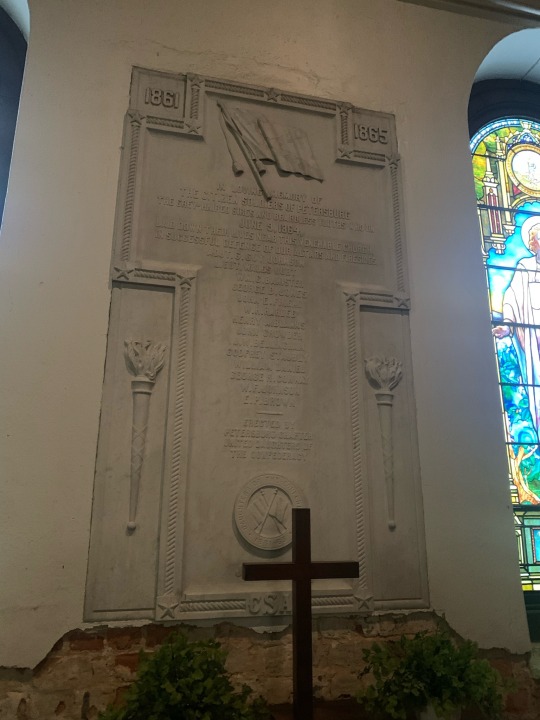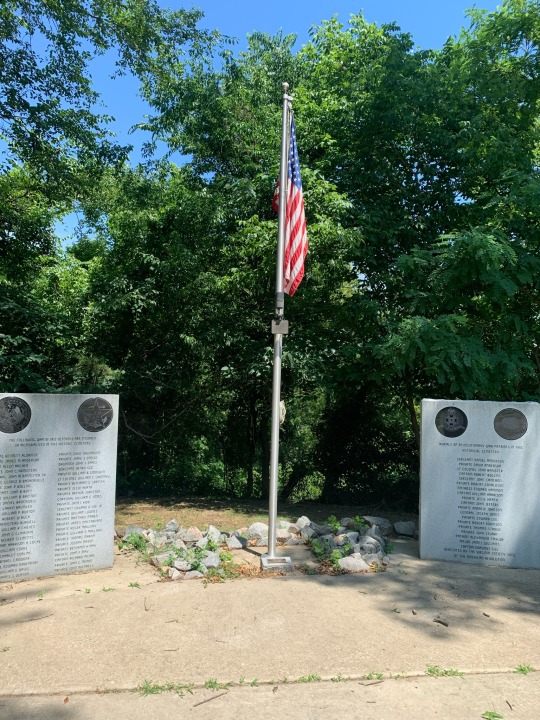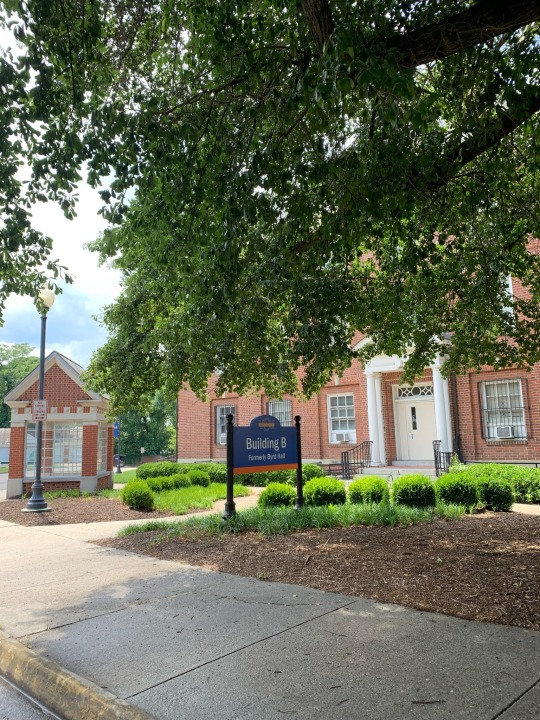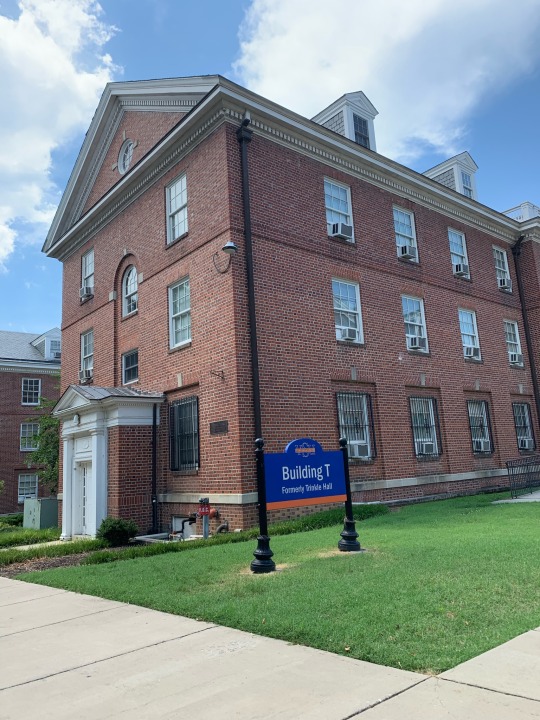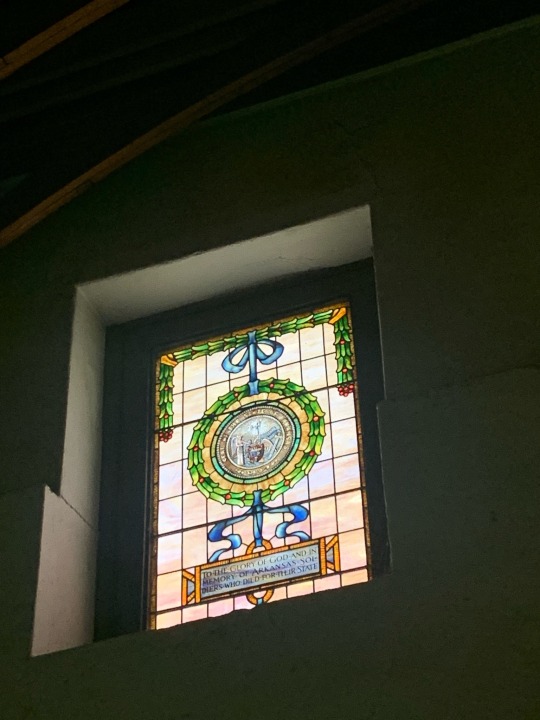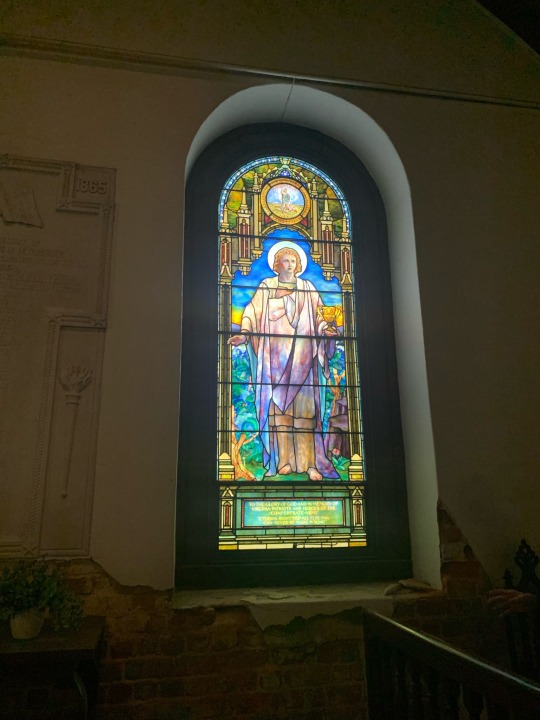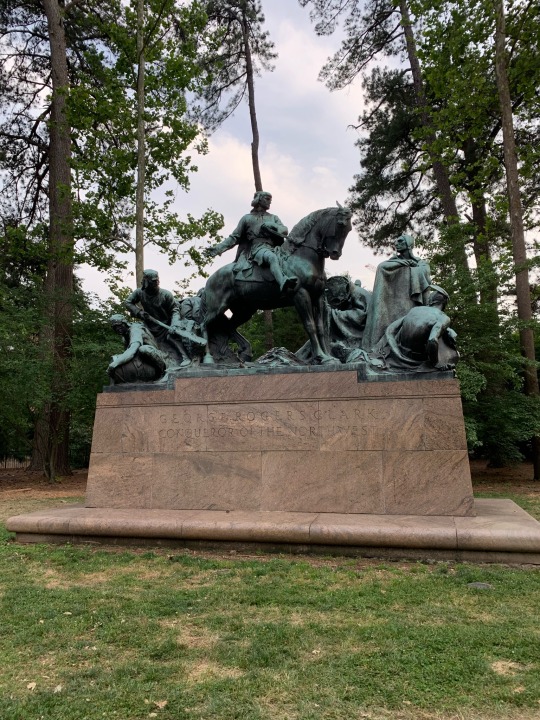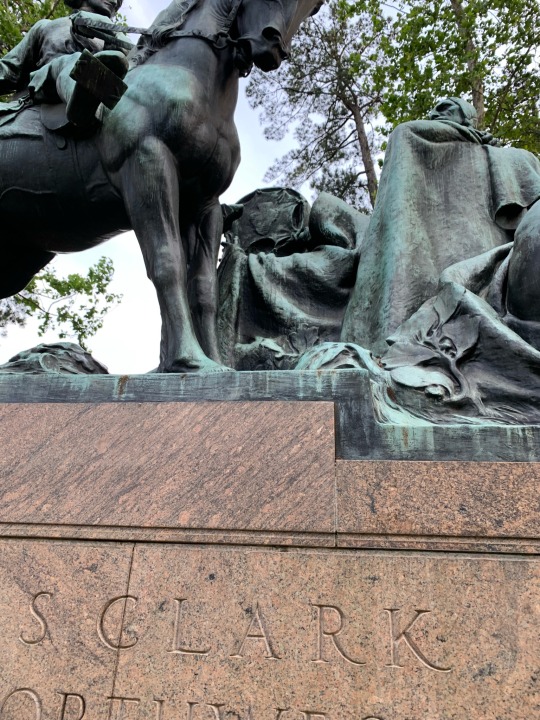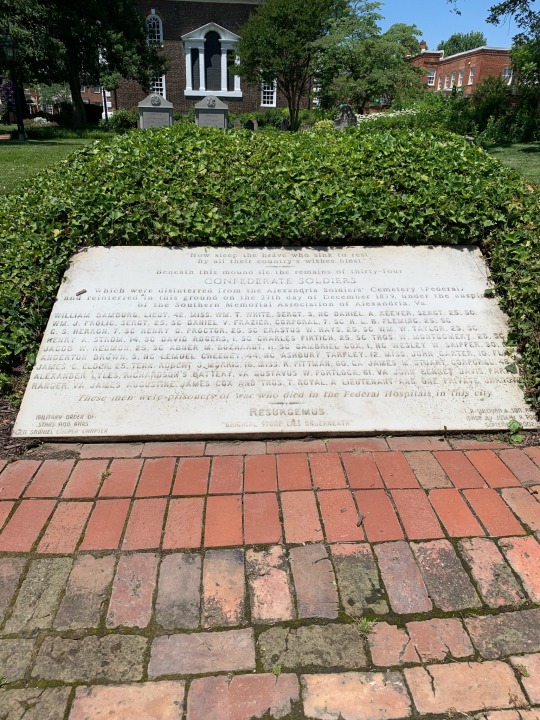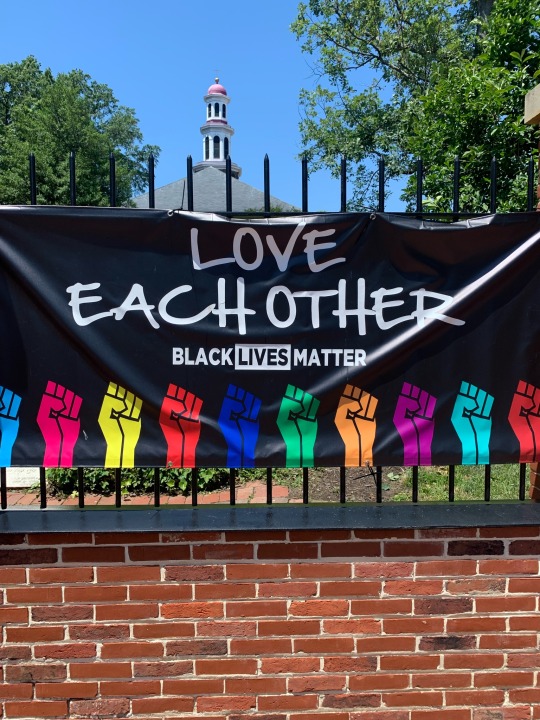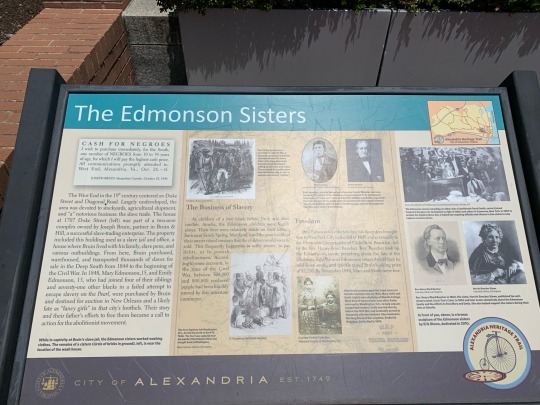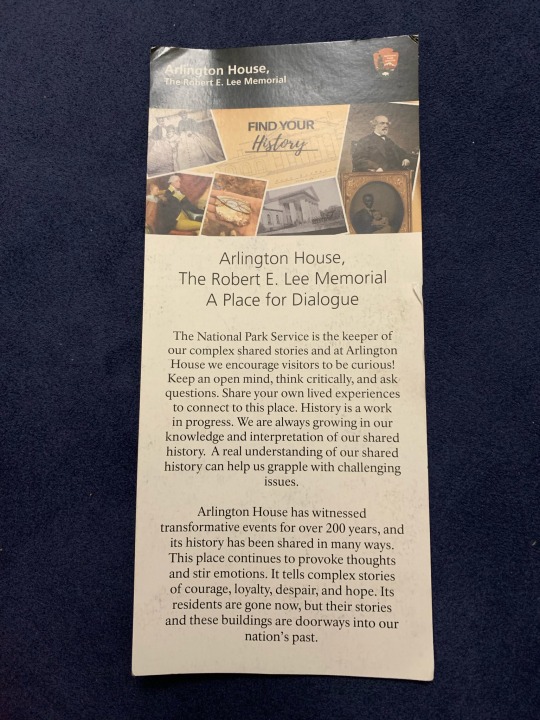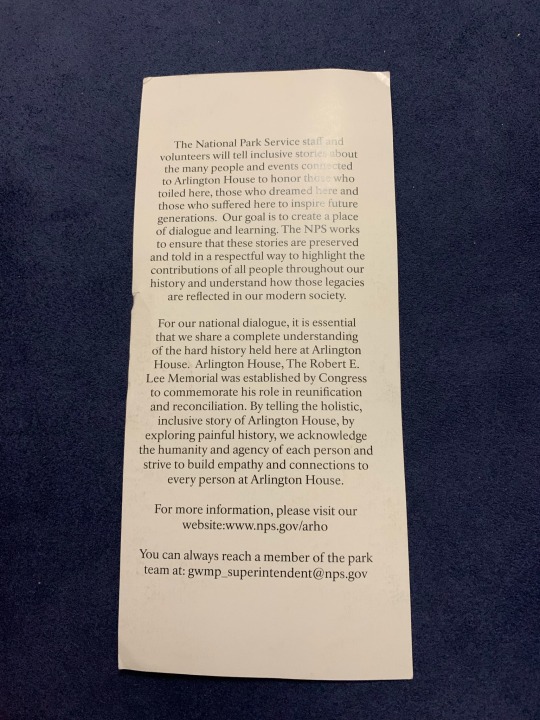Text
Reflections on Charlottesville Monument Removals
Though the Randolph Summer Research Program has officially concluded, we would be remiss if we did not post about the important actions taken in Charlottesville this past Saturday. It took four years, but the Robert E. Lee and Stonewall Jackson statues were finally removed from their stone pedestals. These removals were a long time coming after the Unite the Right rally in August of 2017 and it took a long legal fight with numerous city government votes to get it done. Most city residents joyously packed the streets to see the problematic statues be removed in the morning hours. As we said in a previous post of this blog, the placement of prominent figures of the Confederacy near government buildings many years after the Civil War in the 1920s was primarily meant to intimidate minorities. If this is not just cause to remove the statues, let us consider the emboldened white supremacists with their tiki torches exclaiming “You will not replace us,” and other blatantly racist phrases in 2017.
In an emergency meeting, the City Council of Charlottesville also decided to take down the monument that depicts explorers Merriweather Lewis, William Clark, and Sacagawea. The statue had been criticized recently since Sacagawea, the well-known Shoshone guide, appeared in a crouching position behind Lewis and Clark. As we made clear in our previous Charlottesville post, the two white explorers would have been easily targeted by Native American tribes and nations if it were not for Sacagawea. Marginalizing her to a crouching position did not honor her legacy appropriately whatsoever and most of her descendents were pleased to see the city finally remove such a disingenuous depiction of the important historical figure. The very next day, the University of Virginia decided to remove the problematic George Rogers Clark statue for its troubling depiction of Native Americans and an engraving that uplifts General Clark as a “CONQUEROR OF THE WEST.” Anthony Guy Lopez, a UVA graduate and a tribal member of the Crow Sioux, was quoted in a Washington Post article by Teo Armus and Hannah Natanson calling the twin statue takedowns “an exorcism of state violence” against Native Americans. We should not celebrate the attempted erasure of entire indigenous populations, rather we must focus attention on the issues that today’s Native Americans still struggle to reckon with. They need help and the first step is to listen to them.
It is amazing to see how much has changed in such a short period of time. It was uncertain just a few weeks ago when these statues would come down from their pedestals, but it has now happened. It is up to the City of Charlottesville, as well as the entire Commonwealth of Virginia, to discuss and learn from these consequential removals. As historians, we can confirm that statues coming down is not “erasing history,” as some individuals have been vocally claiming on social media for the past few years. We encourage more books to be cracked open and more museum tickets to be purchased. Learning history is done this way and not by propping up false narratives of the past.
0 notes
Text
Petersburg
At one point, Petersburg was the second-largest city in the Commonwealth of Virginia. Because of its location along the railroad as a hub city, the Union sought to capture Petersburg to isolate Richmond, Virginia's largest city and the Capital of the Confederacy, during the Civil War. While there were some Confederate victories during the siege of Petersburg against the forces of General Ulysses S. Grant, such as the Battle of Crater, General Robert E. Lee was forced to abandon Petersburg and Richmond in early April 1865. The war effectively ended at Appomattox just a few days later. The city rebuilt itself during reconstruction but was never really able to regain its former status. Beyond the Civil War sites, Virginia State University, Pocahontas Island (one of the oldest free Black settlements in the country), and numerous antique shops, Petersburg appeared to be on life support. We intended to visit the nearby Pamplin Historical Park to see their rumored idealized Civil War narratives, but we had to get back to Lynchburg. Petersburg is a city with so much potential, but it is without as much tourism as other parts of Virginia. We encourage all readers to make a journey to this city that is rich with history.
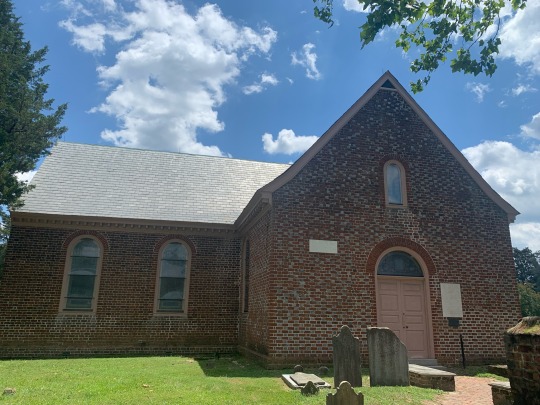
It took us a little while to figure out where Blandford Church and Cemetery was in Petersburg. Apple Maps was struggling and so were we. Ultimately, the Virginia is for Lovers website gave us an exact address and we were on our way. We apprehensively rode into the large cemetery that holds over 30,000 Confederate dead. It did not ease our tension when we entered the parking lot of the visitors center to see vehicles with stickers of the Confederate flag and Trump 2024. We walked in knowing that we had a very different perspective than those inside. We were greeted by two men, one elderly gentleman and one young man. They both were very kind and asked what brought us to Blandford. Josh jumped right in and told them the Cliff Notes version of what our project was. The young man was immediately curious and asked more questions. He ended up offering to give us a tour of the monuments in the cemetery. We followed him through the old roads of the cemetery and made our first stop. It was a monument put up to honor those who fought and died in the War of 1812. The cemetery's earliest grave was from 1702 and the brick church was founded in the 1600s. The history that this cemetery and church holds spans far before the 19th century. The next monument he showed us was a large arch that was dedicated to the 30,000 Confederate dead. It was about a 60 foot tall archway that was titled “To Our Confederate Heroes.” It was put up in 1884 by the Ladies Memorial Association of Petersburg. The organization was formed in 1866 to commemorate the loss of the Confederate dead in the community. The association was responsible for collecting the remains from across the south to create a mass grave of the Confederate soldiers. It was said that the women’s organization wanted to have a solemn place for the Confederates to be buried respectfully. This arch acts as a gateway to the Confederate cemetery. Out of the 30,000, only 3,700 of the soldiers have names upon their graves. It was said best by our tour guide from Historic Jamestowne who is actually a Petersburg native, Mark Summers. “You should never disrespect the dead.” Despite the obvious that none of us support the cause these men fought for, we toured the cemetery with deference. We went to the next monument to the Confederate dead which was the usual private “Johnny Reb” statue atop a column. Our tour guide, who had on a CSA belt buckle and proudly let us know he was a member of the Sons of the Confederate Veterans, began to tell us, in his words, “a southerner's perspective.” “You have to seek this out, it is not used as intimidation to others if it is in the cemetery. It is here to honor the soldiers that are buried beneath him. The private looks to the north ready to face any invaders,” he said to us first describing why the statue is not offensive. This statue is in a cemetery and is in the middle of a Confederate graveyard. There are no Lost Cause sentiments attached to the memorial. Despite the fact that our tour guide's words may be riddled with Lost Cause rhetoric, there was not any on the statue. The young man continued on with his “southerner's perspective.” “But, those statues on the court house grounds, people who want to take them down don’t know why they are there. The court house grounds were where the mothers and daughters said goodbye to their men who were going off to war. It was the last place they ever saw them, so this was a good place for the monument as a memorial,” he said. All three of us could not believe what we were hearing. There is no truth to that statement. As soon as we got back to Randolph, we sought out a Civil War expert and lead American Historian, John d’Entremont, to fact check his statement. He assured us that he was not correct. It was complete Lost Cause propaganda. After this monument stop, that was the end of our tour. We thanked the guide and prepared for our tour of the historic church.
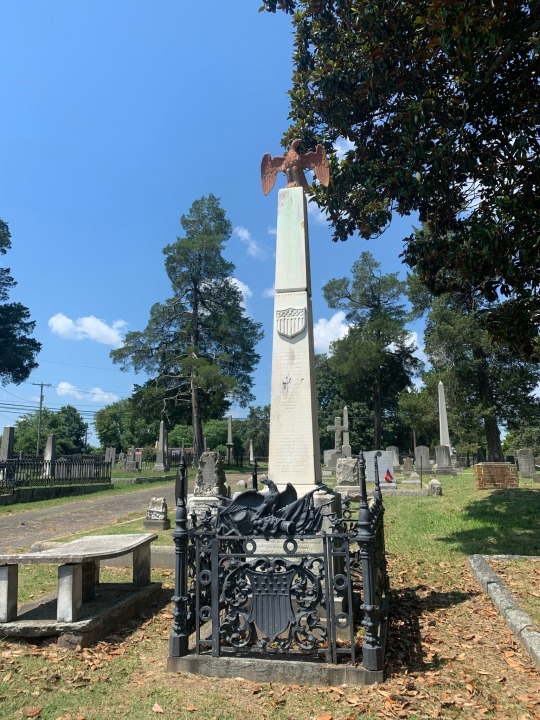
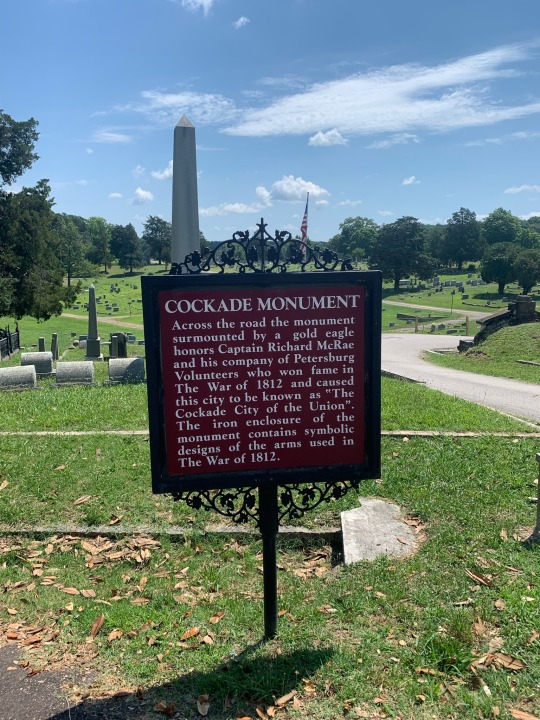
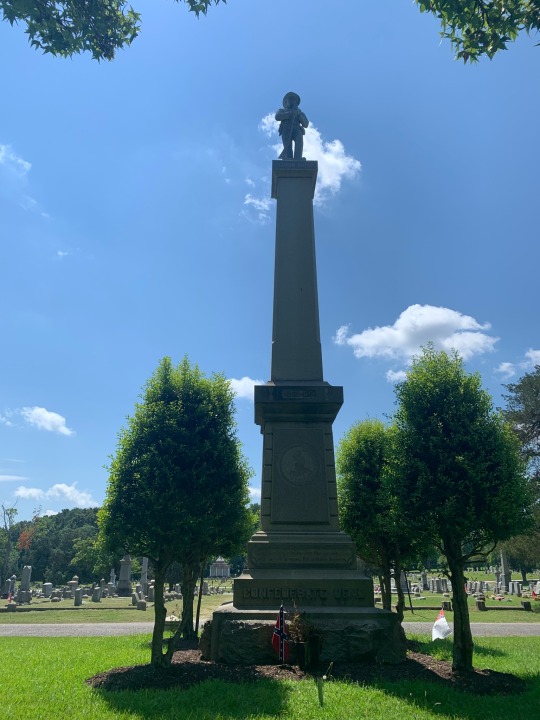
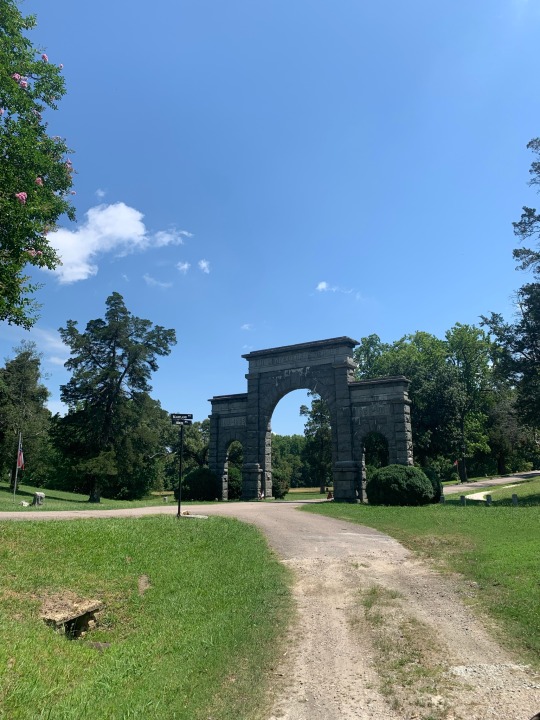
Our tour created a lot of conversation for the research team. We all have differing thoughts on our visit to Blandford and seeing those monuments. We encourage you to ponder whether you think Confederate statues in cemeteries should be taken down or allowed to stay. The monument landscape has always been changing and will continue to change. We are here to encourage you to think for yourself, analyze the monuments, the facts, and come up with your own conclusion.
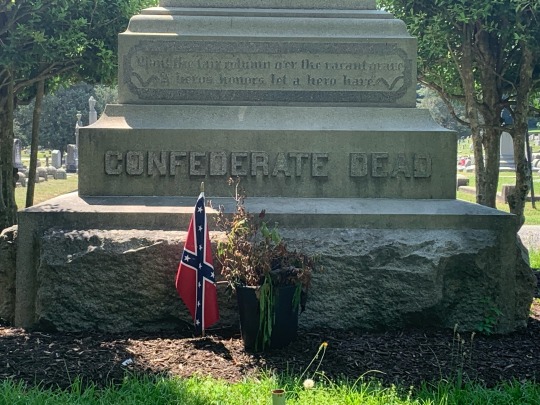
After seeing most of the Confederate graves and signage at the cemetery, we met up with an older gentleman named Gene to lead us on a tour of the Blandford Church up the hill. As the oldest building in Petersburg, the church stands as a memorial for those that died in the Civil War. Our first stop was the grave of Richard Yarbrough, who died in 1702. His grave is the oldest in the entire cemetery. Gene then led us into the dimly lit church. The sun was shining through the beautiful Tiffany stained glass windows. Gene told us that in the 1880s, the Ladies Memorial Association of Petersburg sought to make necessary repairs to the church, which had been abandoned for some time. They added a pulpit, pews, and requested former states of the Confederacy to contribute funds for the stained glass windows. Border states like Maryland and Missouri agreed to be included, but Kentucky declined only due to funding issues. The Ladies Memorial Association appropriated the money on their own to include the border state. Gene told us about each of the saints represented in Louis Comfort Tiffany’s designs. Finally, Gene made it clear that the Confederate flag half-round window above the main door is the only one of its kind made by Tiffany. The city website lists the church as a shrine to the Lost Cause, which it most definitely is. The windows and engravings throughout glorify the mission of the Confederacy, and never mention the enslavement of human beings. There needs to be an overhaul in the interpretation of the church. That being said, Gene was very kind to show us around the church. The church and the cemetery are must-see locations for those trying to understand the issues of upholding the Lost Cause lies.

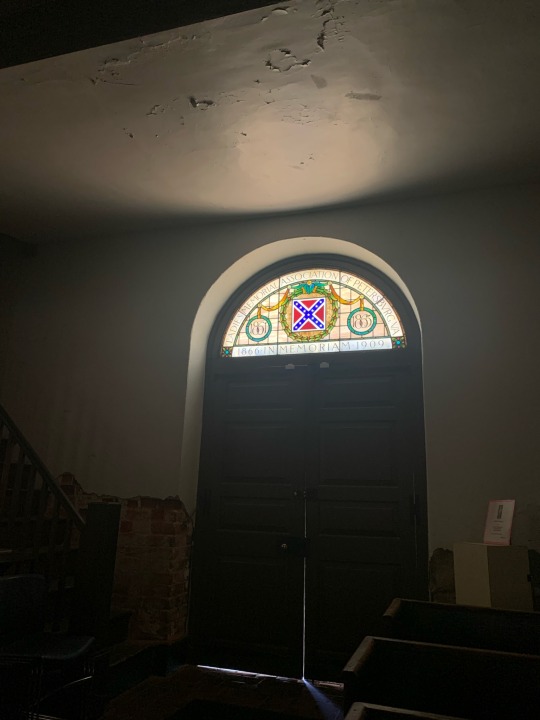

Our very last stop on our summer adventure was at Virginia State University. In our research of newspaper articles, we saw where VSU removed four names from dormitories and academic buildings. Byrd, Eggleston, Vawter, and Trinkle Halls are all now in the process of having their name changed. The official statement from the university reads: “ … the current names do not reflect the rich heritage and spirit of the Virginia State.” Harry Floyd Byrd and Elbert Lee Trinkle were governors of the Commonwealth in the 20th century who held beliefs that VSU does not support. Dr. Joseph Eggleston was a member of the Board of Visitors who also held questionable beliefs. Charles E. Vawter was the school’s rector and the university has decided he does not reflect what VSU would like to portray. Instead of jumping the gun and quickly removing the names and replacing them without thought, VSU has a team of scholars, former students, and current students to find names that do reflect the mission of the university. Now the names are simple (Building B, T, V, and E) and only temporary. VSU is taking the correct steps in using their renaming process as an educational opportunity for faculty, students, and alumni.
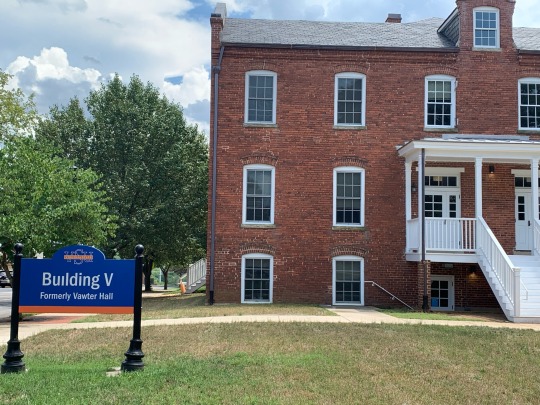
0 notes
Text
Historic Jamestowne
In 1889 Mary Jeffery Galt and Cynthia Beverley Tucker Coleman founded The Association for the Preservation of Virginia Antiquities, which is now known as Preservation Virginia. The organization was the first statewide preservation association in the United States. Their second purchase was what is now Historic Jamestowne in 1893. When the foundation first acquired the site, their focus was to return fame to Virginia instead of letting their colonial history be overshadowed by Plymouth Rock stories and the American Civil War. This included the construction of the 103 foot tall (one foot per colonist that arrived in May 1607) structure known as the Tercentennial Monument. In 1907, three hundred years after the 1607 colonial arrival, archaeological excavations began on the property. From 1907 to 1994 the organization believed that the original fort was underwater in the James River. When excavations began in 1994, a landmark discovery was made: the fort was still there under the feet of archaeologists. Since 1994, Historic Jamestowne has been a leader in preservation and interpretation of colonial history. We were able to see the interpreters and archaeologists in action during our visit. Beginning with our tour with the Director of Public and Youth Programs, Mark Summers, and ending with a conversation with the Senior Staff Archaeologist, Mary Anna R. Hartley, we got the opportunity to have an inside look at the outdoor museum.
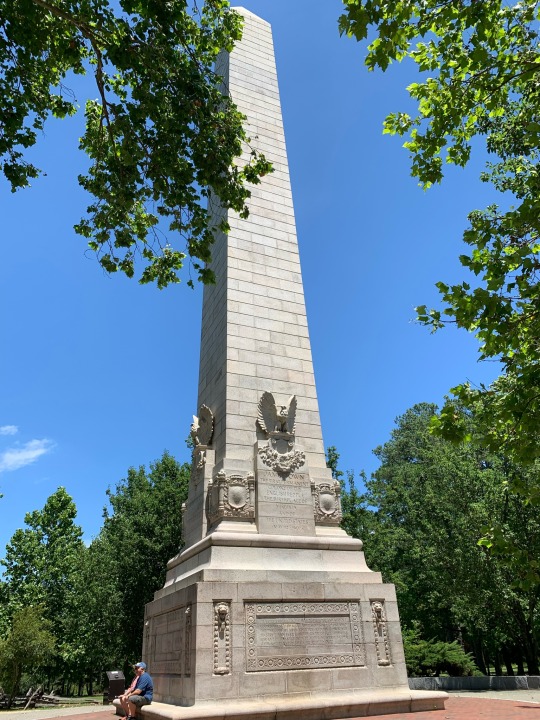
Mark Summers gives tours daily at Historic Jamestowne. They vary from many topics and interests about the first permanent settlement. For children, the foundation has created live history tours with a “first colonist”, Anas Todkill, so children can hear the history of Jamestowne from a colonial person's perspective. Summers’s primary tours are the Powhatan and the English and the First Africans. Summers was giving the Powhatan and the English tour on the day we attended. We were impressed with his oratorical skills, knowledge of the fort, and his enthusiasm for his job. This tour was first created for the military to explain how leadership evolves over time dependent on the goal at hand. Later the foundation realized it would be a great tour to explain this, as well as the relationships between the Powhatan and the colonists to visitors. He explained to us that Jamestown had a certain prestige for the English at the time. There had been attempts sixty years prior to conquer the land, but they ultimately failed. The Powhatan knew what was coming when they saw the ships coming towards their land. Summers made that clear. “It’s not like the movies you see with the Powhatan cowering when the ships approach. They stood tall and had experience with these people. I seek to dismantle the idea that the Powhatan were afraid,” said Summers. After he explained to us this very important point, he asked us if the long violence and warfare between the Powhatan and English was “preventable or inevitable?” and told us that it was our choice to decide, based on the interpretation of the facts. In hopes to keep some mystery about the tour so you as a reader can hopefully make the decision on your own if you attend, we won’t tell you all the details. Summers went through the fort telling us about landmark military moments, decisions, and mistakes that the Powhatan and English made. He kept us thinking and involved by asking us questions to ponder and even answer during the tour. We finished up with the statue of John Smith and the discussion of Smith, the Powhatan, and the ultimate fate of those within and around the fort. With his large personality and expressive voice, Summers brought a crowd around to finish the tour. He allowed us to see many different perspectives and left us thinking further about the topics discussed. “The interpretation of history is always changing based on new evidence. I may change my mind next week about something if I find more evidence. That’s how it is being a historian,” said Summers in a talk after the tour. Summers has worked at many different sites in Virginia, but has never had such concrete sources of information and freedom of correctly interpreting history as he has at Historic Jamestowne. He made it clear that the history we were learning from 1607 “was the beginning of what would be the United States, but also led us to our darkest places like Wounded Knee.” His other tour, First Africans, was created to answer the “combative and sometimes racist” questions visitors sometimes ask in a typical tour. Summers left us with a piece of advice all budding historians need to hear. As a good historic site or historian, one must be “willing to be unpopular.” Telling the true stories is not always what visitors want to hear, but it is what they need to hear.
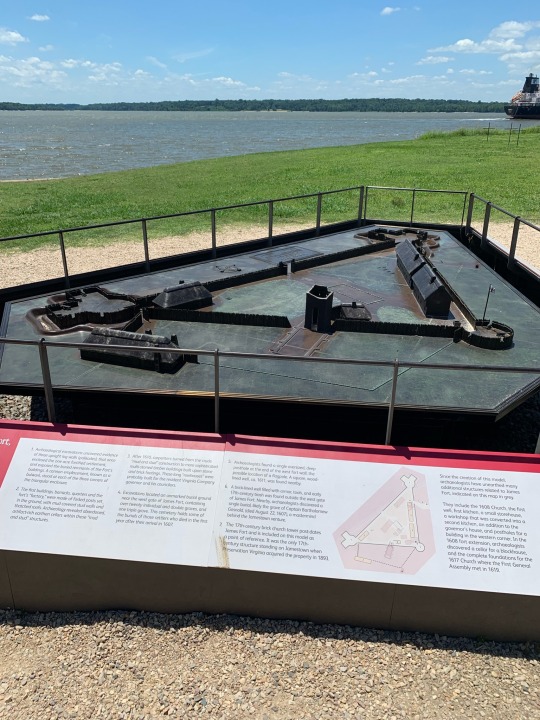
Since 1994, Jamestown Rediscovery has been working tirelessly to find the remains of the original James Fort which dates back to 1607. Millions of artifacts have been found and evidence of the original placement of structures has been established. We were able to see the wooden palisades, the memorial church, and other ongoing dig sites. The archaeological team is primarily focusing on the seawall, and we were able to see some staff members in action. Luckily, a Randolph-Macon Woman’s College graduate is involved with the leadership of archaeology at Historic Jamestowne. Mary Anna R. Hartley was joined by David Givens (Director of Archaeology) when meeting us outside of the 17th-Century church tower. They were able to tell us about the ongoing interpretation of English and indigenous artifacts at the Archaearium, as well as their limitations with being a small non-profit organization. Most recently, the Governor’s office has been in contact with the archaeological team about the time capsule within the Richmond Robert E. Lee statue. When and if it comes down, the team will be eager to find what is contained. David and Mary Anna lead an important organization that presents all elements of Jamestown's history. This includes the horrifying “starving times” when settlers turned to cannibalism to survive, as well as the strained relationship between the English and the Powhatan. We cannot thank David and Mary Anna enough for taking the time to speak with us.
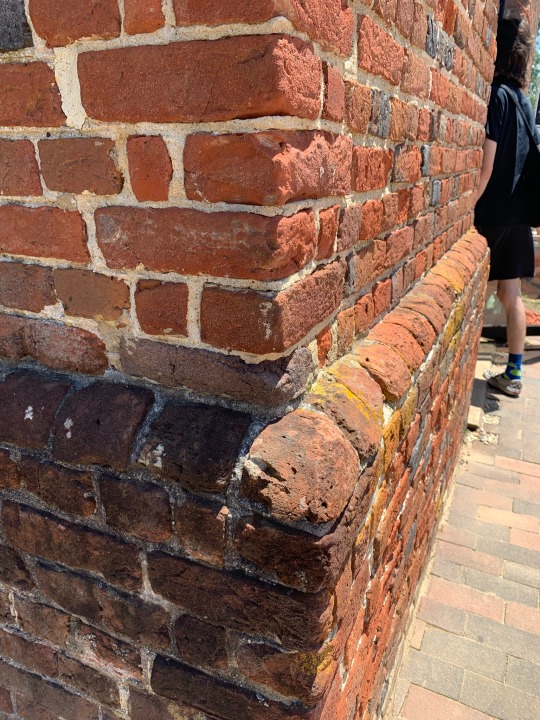

Upon Josh’s last visit to Jamestown with Randolph’s American Culture Program, the Pocahontas appeared problematic. With her hands at her sides, the wife of John Rolfe and daughter of Chief Powhatan (Wahunsenacawh) appears to welcome everyone to Jamestown, but her story is far more complicated than the statue conveys. Disney famously got her story wrong in the 1995 animated film as she did not marry John Smith. In truth, she was a victim of human trafficking who was likely forced to marry a white man for a period of peace. White Americans have been obsessed with the mythic story of Pocahontas for decades because she was a “good Indian” that absorbed the practices of Christianity and English customs. The true Pocahontas did not hate her own culture and find it obsolete. The bottom line is that Historic Jamestowne, as well as the Jamestown Settlement, need to continue sharing the truth of the most famous Native American woman. Her story matters and the statue that takes a central part at the site needs to be displayed in context. Visitors should know that the statue was moved at one point and that the fort itself was established on the stolen land of Pocahontas’ people.
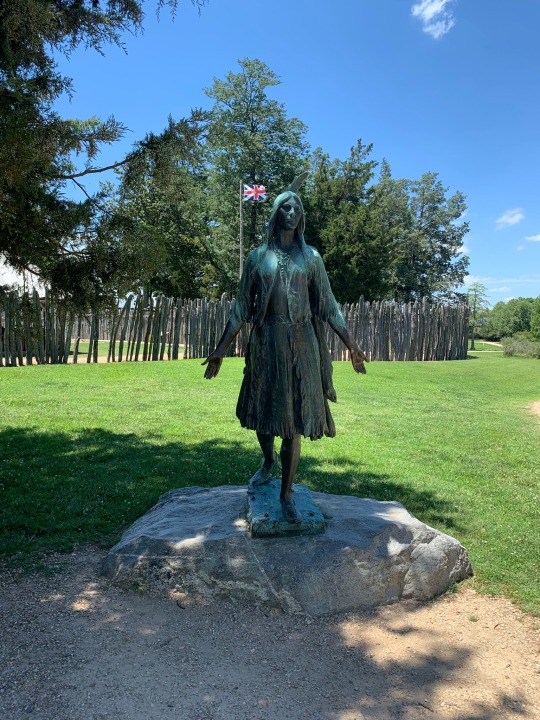
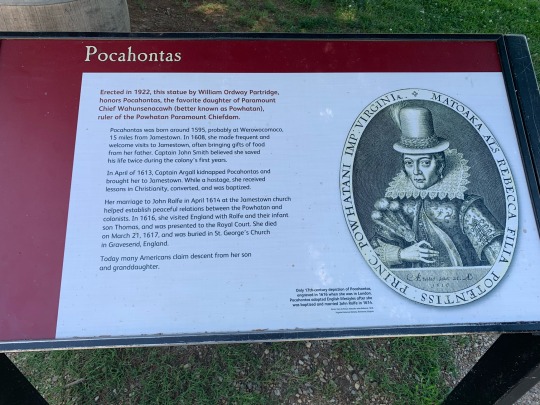
Before we left Historic Jamestowne, we headed down to the Angela site and the Ambler Mansion ruins. Angela is the first recorded African woman at Jamestown. In this area, we encountered signage about the First Africans in 1619. We learned that The White Lion and Treasurer were English privateer vessels that robbed an estimated 60 Africans to bring them to Virginia. The property that was owned by Captain William Pierce is where Angela is the only known site of where one of the first Africans lived and worked. This type of history deserves to be conveyed at Jamestown since it allows a greater understanding of how an economy based on slavery became normal in Virginia, and other parts of the Americas. It is important to remember the name Angela. That is how we guarantee personhood to one of the first Africans in Virginia
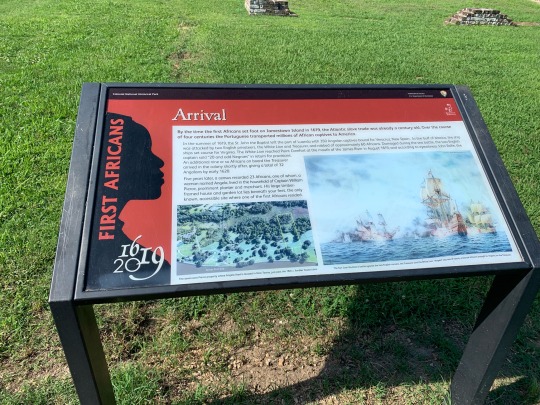
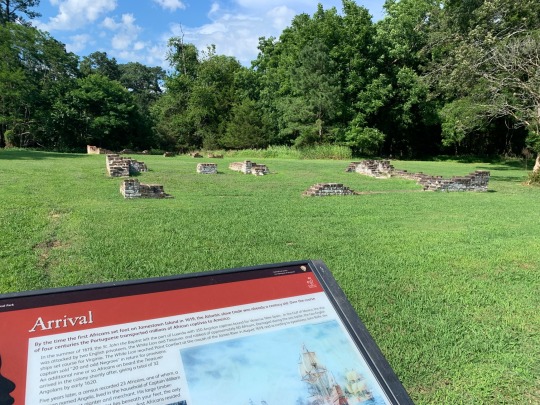
0 notes
Text
Colonial Williamsburg
As one of the largest living history museums in the country, Colonial Williamsburg is a place where many families from all over plan their summer vacations. With the financial support of John D. Rockefeller Jr., Reverend Dr. William Archer Rutherfoord Goodwin decided to restore the former colonial capital of Virginia in 1926. 88 buildings at the site are preserved originals with the others being fully restored. There are trade shops, homes, and other businesses with ongoing interpretation and activities led by staff in the clothing of the time before the American Revolution. Though it is an effective site that shows an idealistic version of life for residents of the coastal town, it has not been without its problems within the stories told or the types of visitors that befall the area. Colonial Williamsburg must be one of the leaders in discussing the hard truths of the past. We can then work together for equity and justice for all in the present. It may make a world of difference for future generations to hear the complicated story of our nation’s founding. This would not inspire hate for the United States, but it would motivate visitors to the aspiration of a more perfect union.

We were very fortunate to meet with a long time employee of Colonial Williamsburg who detailed experiences of themselves and their colleagues. Without a doubt in any institution, there are things that are forced behind a curtain to save face. Colonial Williamsburg is not innocent and has its skeletons in the closet. We learned of the problematic beginnings of the outdoor museum. In the beginning of restoration to the historic town center, many residents resisted the changes. The community that resided in what is now Colonial Williamsburg was 54% African American. The area was impoverished when Goodwin and Rockefeller began their journey to gain land. One reason why the foundation was able to have so many original homes was due to families passing them down generation to generation. Goodwin would actually buy the land under the homes because technically most of the residents would only own the house itself, not the land. Even when they resisted, they had no choice but to move. The employee told us this important story, but made it known that this is not a history that Colonial Williamsburg readily shares. The foundation would rather cover up their sins, rather than face them. The employee continued by telling us that it was wonderful the museum had finally opened up and interpreted about enslavement during colonial times, but it was not all it was cracked up to be. The Randolph House is the only area that you will hear about enslaved people at Colonial Williamsburg. In any other tour of the over 50 building campus, you will not hear about the enslaved. You may get a guide who is open and progressive enough to toe the line of the hard, yet important, topic of slavery, but most will not and the foundation doesn’t really want them to. “A Republican Disneyland'' is what the employee called the idealistic Colonial museum. You can directly avoid the hard history of African Americans, the realities for women of the Colonial period, and other tough histories. While the replica of the small town is beautiful and correctly shares the history it chooses to tell, it uplifts a certain narrative. The employee talked of African American men and women being called out to with racial slurs when they are dressed in Colonial garb. “African Americans are more in danger in Colonial dress rather than street clothes,” they said. The employee also commented that young women are victims. Some guests go too far and think that it is alright to touch the young women when dressed in the Colonial style. “Mostly it is male guests who feel as if they can take advantage of those who were oppressed in Colonial times (women, African Americans) when visiting.” This sadly did not come as a surprise when we heard speakers announce on the shuttle ride over to the museum: “ … We do not tolerate racist or sexist jokes, comments, or harassment from our guests or employees. Please do not touch the interpreters.” It was shocking to hear on the intercom, but not so shocking to us once we heard the true stories. We are not saying Colonial Williamsburg is the only museum with harsh realities such as these. Most likely, every other place that we have been to this summer has similar instances, but we got a behind the scenes here. We share this story in hopes for those attending in the future to ask more questions when around the interpreters. We encourage all to understand that the idealized Colonial Williamsburg is not a full narrative.
The arrival of the colonists may have led to the rise of Williamsburg as Virginia’s capital city, but the English were certainly not the original inhabitants of the land. At its peak before 1607, the Powhatan Confederacy controlled more than 30 tribes throughout Tidewater Virginia, and some portions of the Eastern Shore. The original tribes under Wahunsenacawh (Chief Powhatan) included the Powhatan (proper), the Arrohateck, the Appamattuck, the Pamunkey, the Mattaponi, and the Chiskiack. We were able to meet with Kody Grant, an American Indian interpreter at Colonial Williamsburg who is an enrolled member of the Pueblo of Isleta. Kody also has family ties to the Eastern Band of the Cherokee. It only took one question for Kody to give us a complete narrative of what life was like in Williamsburg for the Powhatan, as well as the sovereign tribes that sent political delegations to the city. He told us about the young men that attended the Brafferton Indian School at William and Mary before it closed during the American Revolution. Of course, there was the mention of conflicts between local tribes and the colonists, but Kody also mentioned periods of peace and trade between the factions. There was one treaty between the Pamunkey, the Mattaponi, and the colonial governor in the late 1600s. For about 343 years, there has been a tradition of presenting deer and gifts to the Virginia government the day before Thanksgiving. Governor Northam has continued this centuries-old practice with the deer meat being donated to local food shelters. In knowing what has been perpetuated by the United States government against indigenous groups to this day, this custom shows the importance of keeping to one's word and respecting all cultures. In talking with Kody, we were conveyed the truth of Native Americans not being a monolithic civilization. Their interests, languages, and cultures are unique. We are unable to remedy the great horrors of the past, but the one thing we should be doing is listening. Kody is just one interpreter out there who can share his story, as well as others. There should be a mutual commitment to remember, memorialize, and commemorate the ever-present people whose cultures are alive and well. American Indian interpreters at Colonial Williamsburg are a perfect example of such a commitment.

After taking a lunch and caffeine break, we went back into the large outdoor museum to attend the Freedom’s Paradox tour. The only advertisement or description of the tour we saw was in the Guest Experience print out sheet. On this tour, one is able to “explore the paradox of the institution of slavery.” We were all curious about it as this is the only tour that discusses the enslaved people of Colonial Williamsburg. We were joined by only one another group on the tour, so we got to interact with our knowledgeable guide frequently. He was a younger man who was quiet, yet so intelligent on the subject. Not all guides have to be so exuberant, and he did a great job of being informative and enthralling. He told us all about the enslaved people at the Randolph House in great detail by name. We continued on the tour for him to tell us about how the enslaved people were the ones at Colonial Williamsburg to cultivate the currency of Virginia: tobacco. He explained that the crop was the main source of revenue for the young colony, but none of those who worked the land reaped those benefits. He explained that the tobacco industry should be discussed as it is and has always been: a drug business. He did not make any excuses and told us the true stories of the enslaved. Once we arrived at the courthouse, he explained that if you were any race other than white, you would be tried to be punished or killed regardless of innocence or guilt. The color of your skin usually dictated your verdict. This honest and open tour that was constantly open for conversation showed us all that Colonial Williamsburg is slowly beginning to change for the better.
0 notes
Text
Fort Monroe
Fort Monroe is an area rich in history. Before the settlement of British colonists in 1607 at Jamestown, Cape Comfort was occupied by Native American groups for hundreds of years. The first Africans that were brought to North America arrived in the Hampton Roads region in 1619. John Rolfe wrote a letter to Sir Edwin Sandys of the Virginia Company about the arrival of “Twenty and odd Negroes.” Race-based enslavement would eventually become normalized in the decades to come. Though the original colonists attempted to fortify what is now known as Old Point Comfort repeatedly, destruction always ensued leaving the area vulnerable to competing entities. It was not until after the War of 1812 that the young United States Army constructed Fort Monroe as a part of a defense strategy against future attacks. Construction began in 1819 and was not fully completed until much later in 1836. A young Robert E. Lee directed the final phase of construction between 1831-1834. Ironically, Lee had constructed a Union stronghold essential during the Civil War when much of Virginia was in the hands of the Confederacy. Abraham Lincoln visited the fort briefly for four nights during the war and saw the USS Monitor and the CSS Virginia fighting in the nearby waters. Though a Virginia slave owner demanded the return of escaped enslaved persons at Fort Monroe in 1861, General Benjamin Butler refused as they were a “contraband of war.” This action led to the United States Congress adopting the First Confiscation Act, which meant that escaped enslaved persons from an active state in rebellion would be kept out of the hands of Southern slave owners. Just a few years later in 1863, Lincoln’s Emancipation Proclamation made it clear that the North was intent on ending slavery for good. Since former President Barack Obama designated Fort Monroe as a national monument in 2011 after its formal decommission by the Army, the National Park Service can fully interpret all components of the site. This includes the two-year confinement of Jefferson Davis at the fort, as well as its strategic importance during World War I and World War II. It is a site that shows the benefits of historic preservation and redevelopment, and we felt a unique sense of fulfillment incorporating the fort into our last journey of this project.
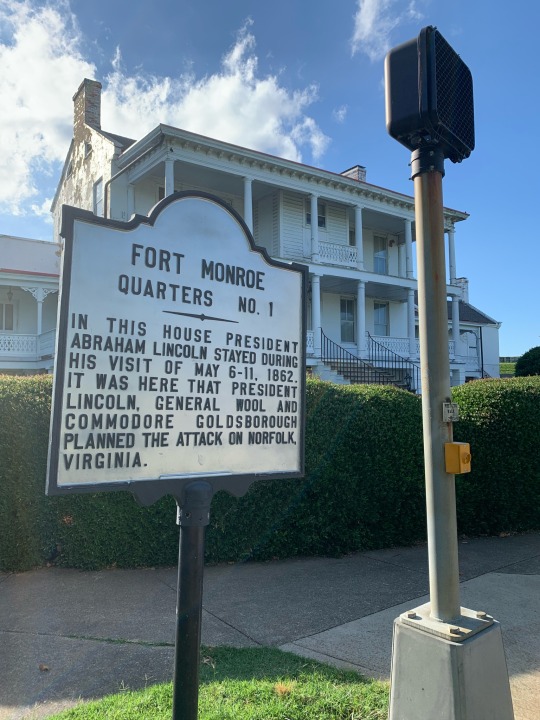
Once we had driven around the large fort for about fifteen minutes, we finally found a map that helped us find all the important landmarks we wanted to see. As we were pulling away, we came across our first stop. There was a historic marker at the top of the Casemate Museum that caught all of our attention. “Confinement of Jefferson Davis” is what the marker was titled. At Fort Monroe, in what is now the Casemate Museum, Davis spent the first four and a half months of his short two year prison sentence. The 1932 marker only detailed facts about his imprisonment, but right below this sign was a plaque installed by the United Daughters of the Confederacy that was riddled with the Lost Cause narrative. The plaque honors Dr. John J. Craven, U.S. Army doctor, who took care of Davis as he was imprisoned. He, according to the UDC, “lightened the monotony, loneliness, and the physical suffering of Jefferson Davis.” The sign did not stop there with the odd language of calling Davis a “prisoner of war.” He was not a prisoner of war. The war was over, Davis was imprisoned because of his crimes of treason. He was never tried and was released after two years. It is an example of one of the largest injustices in our country’s history that added fuel to the fire of the Lost Cause.
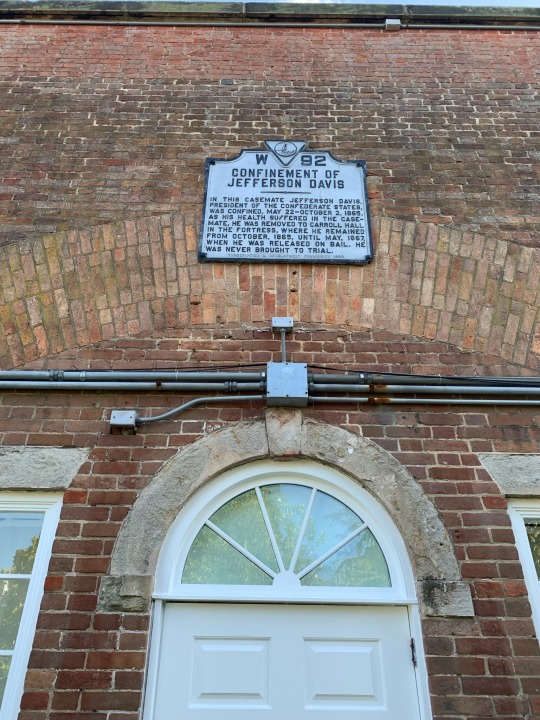
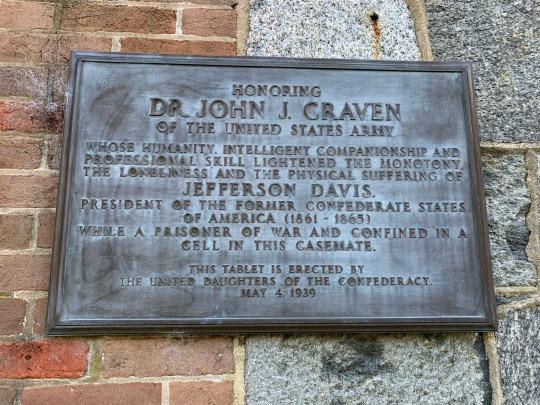
Just down the road we came across an arch above a large hill, overlooking the ocean across the way. It was formerly an entrance to a small memorial park to Jefferson Davis. The UDC installed the overwhelming metal arch in 1956 with the approval of the US Army to “commemorate the imprisonment of Confederate President Jefferson Davis at Fort Monroe.” It was shocking, but also quite expected for the times, to us that the US Army would approve the arch dedicated to a traitor. It was also unsettling because of what was happening in our country at the time. In the 1950s and 1960s the rise of the modern Civil Rights Movement was taking place. Organizations, like the UDC, were making sure their presence was known and making racist statements across the country. In August 2019 the name of the park was removed and the area was reinterpreted. We were all impressed with the signage from the National Park Service that told the full truth about what the memorial park was and meant for those who installed it. The signage was blatantly honest about why the arch was put up, along with the many other types of Confederate memorials across the South. The signage states that these memorials “ … highlight(s) the intent to exclude African Americans from public life and civil liberties.” The signage even speaks to how “ … Davis stood as the most vocal proponent of the claim the war had been a constitutional struggle, not a fight over the future of slavery in the United States, His claim was part of the Lost Cause crusade….” It was a proud moment to see how well the NPS is interpreting the history of the past mistakes at Fort Monroe. Lastly, as we stood under the arch, overlooking the ocean, we could see the signage for where the proposed First Africans memorial will go. We couldn’t tell if this was a coincidence or just a powerful twist of fate for the two sites to coincide in such a way. We are thankful for the correct interpretation of history here at Fort Monroe.
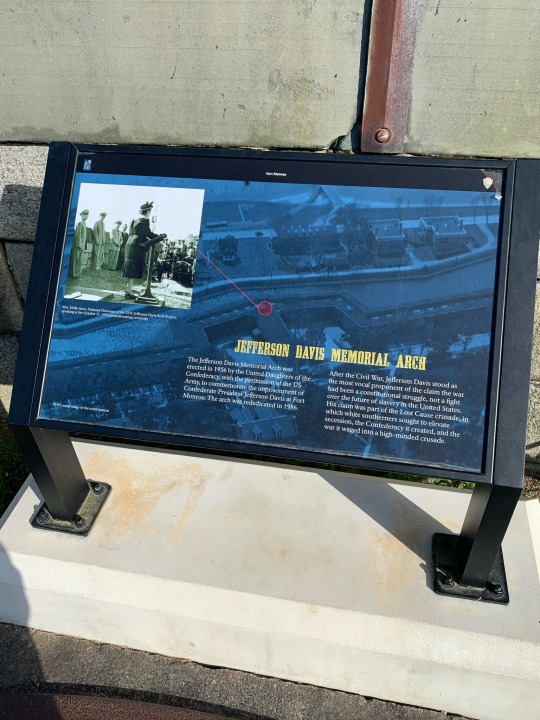
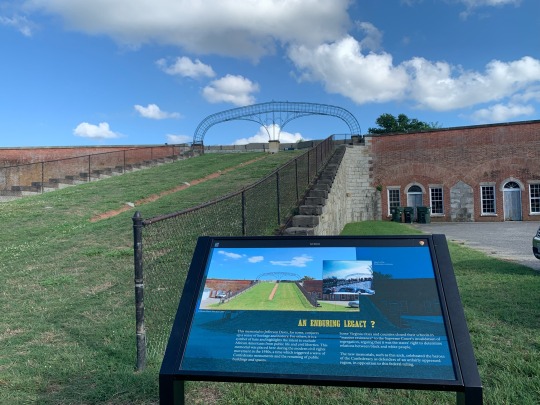
Before Fort Monroe was a military installation, Old Point Comfort was where the White Lion brought African captives to be sold into indentured servitude. The arrival of the 20-30 Bantu Angolans was the catalyst for slavery in America. We were able to park near a fishing pier and easily found the sign. The sign explains the arrival briefly and also introduces a couple, Antony and Isabella, who were two captives on the White Lion. They had a child named William, who is believed to be the first child born in Virginia with African ancestry. The sign concludes with a statement confirming the facts of Virginia creating a system of hereditary slavery, which would last until 1865 with the ratification of the 13th amendment. Each of us had an emotional reaction to seeing this historical sign as the sun went down for the day. We looked out towards the ocean, closed our eyes, and heard the crashing waters below. This place is where one of the greatest travesties of United States history began to form as an institution. After shedding a few tears, we walked down to the future site of the African Landing Memorial. Sculpted by Brian Owens, the memorial will allow further reflection upon America’s greatest violation of human rights and dignity. To move forward, one must look to errors of the past. If all Americans can do this, maybe we will be able to realize the true potential of a free nation.

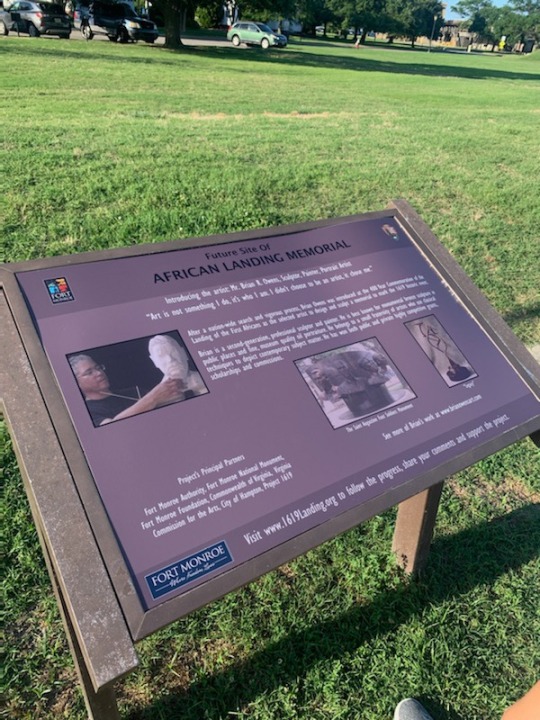
Our last stops at the fort were two signs detailing the former locations of the Contraband Hospital and Contraband Quarters. In the beginning of the Civil War, General Benjamin Butler took in hundreds of enslaved people who had run away from the hands of those who owned them. He called them “Contrabands of War” as they were property of those who they were fighting against and General Butler confiscated such “useful property.” There was no mention of emancipation, but ultimately this policy led to thousands of formerly enslaved workers to be freed. The resilience the enslaved had to make such a journey from all over the South is a momentous accomplishment. Freedom was never easy to achieve and the hard fight never came without hardship. After travelling the long roads to freedom, most of the men, women, and children had been injured or faced illness along the way. The Contraband Hospital was set up exclusively for the freed people who were facing these struggles. Harriet Tubman worked as a nurse at the Fort Monroe hospital for a short period of time. Fort Monroe holds some of our earliest histories, darkest moments, and many highlights that are important for all Americans to see and remember.

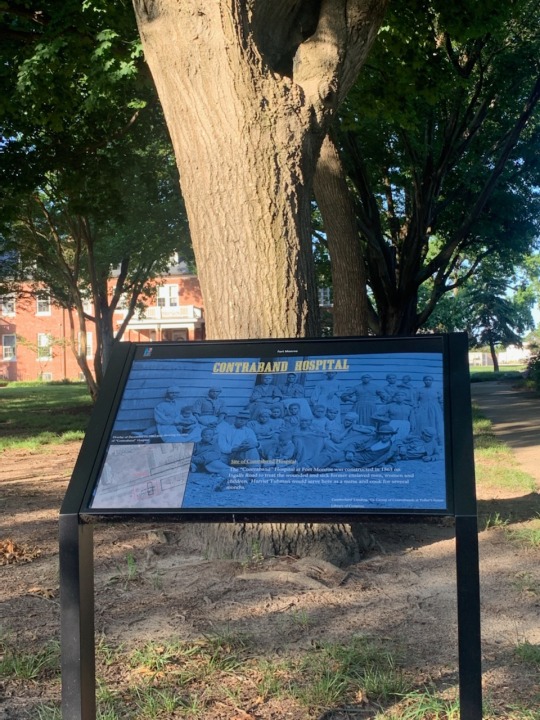
Our final stop in the Hampton area was the small town of Phoebus. A small, rundown town in the middle of a revitalization, stood out to us as we were on the way back from Fort Monroe. Only about a mile away from Phoebus is a national cemetery for servicemen and women. But, the most interesting piece of history we discovered was a small historic marker that was titled “Slabtown.” Slabtowns were the pop up neighborhoods of the hundreds of freed people making homes for themselves out of slabs, which are leftover cuts of bark from the local sawmill. Many of those freed people’s descendants still live in Phoebus and surrounding areas today. We found this stop to be inspiring as not only does their story live on, but their familial legacy too.
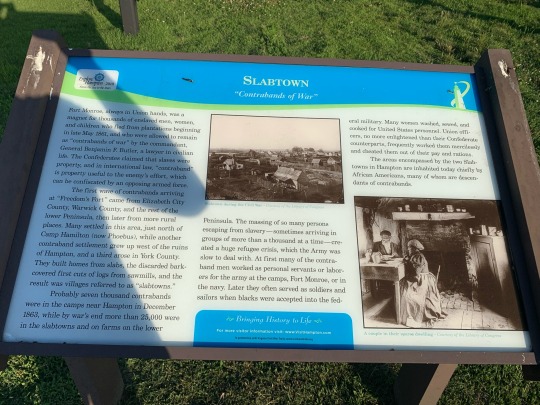
0 notes
Text
Orange County: James Madison’s Montpelier
Because we have a connection at James Madison’s Montpelier, we were fortunate to get an offer of a lifetime to have a private tour and meet individuals doing important historical interpretation. Zeb Gray, who was a non-traditional aged student at Randolph College, made the home that belonged to the Father of the Constitution come alive with stories of the Madison’s, as well as the many enslaved. The first few people that Zeb introduced us to included dedicated workers of the archaeology team with Dr. Mary Furlong-Minkoff as the curator. Mary was kind enough to introduce us to a gentleman named Dennis, who made a fascinating discovery amongst a series of flags placed with the help of a metal detector. Dennis found a small shovel used to scoop ashes from a fire. This small piece of material culture was likely used by either enslaved workers at the plantation or by free workers during the ownership of the Dupont family. It was remarkable to see the excitement on the faces of Mary and Dennis as the discovery was made. Interestingly, Dennis placed the shovel back into the ground to ensure it would be preserved properly. Mary explained reburying the artifacts can sometimes be the best method of preservation. Dennis also told us about the most intense find he ever made at the site. He found a piece of ordnance dated to the Civil War, which required the bomb squad to be called for safe detonation. Our jaws dropped when we heard his narration of events from that day. We have a great deal of respect for what Dennis has accomplished in his time at Montpelier. Next, we walked down to the archaeological field school, where graduate-level students and other volunteers were brushing off items found in the current dig site that they were currently working around. There were many metal fragments from horseshoes that made it clear that a blacksmith shop once stood in the place where the current focus of the excavation was taking place. We spoke to three field school students named Margaret McCormick of Randolph-Macon College, Olivia Meoni of the University of Maryland, and Jennifer McGee of William and Mary. Each of these young and dedicated archaeologists had pride in the discoveries made and seemed efficiently prepared to detail even the smallest pieces of metal. We do not doubt that each of them has the spirit and the drive to continue their work at Montpelier and beyond. Zeb went far and beyond our request for a tour at Montpelier. We cannot thank him enough for allowing us to meet with such amazing folks. It is through the work of archaeologists that historians can make more sense of the lives of those from the past. Only with archaeological artifacts can credible historical narratives begin to form.
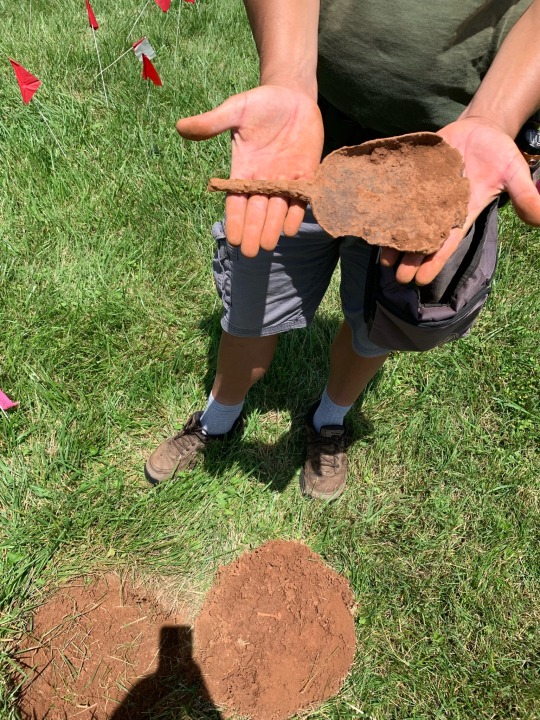
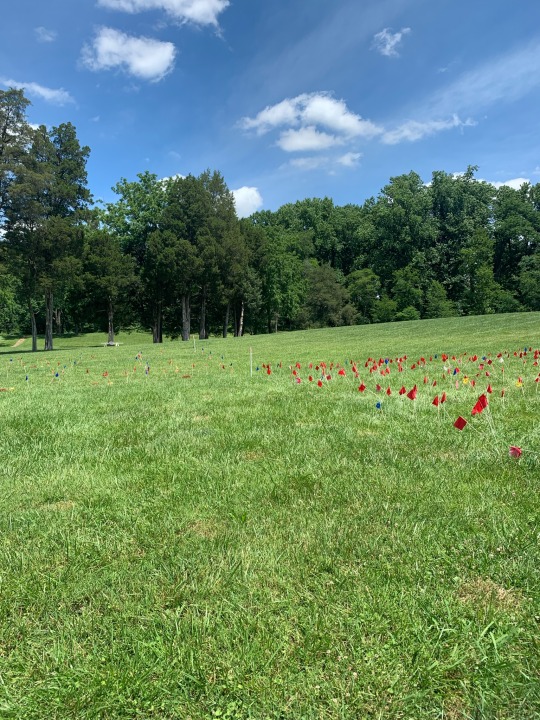
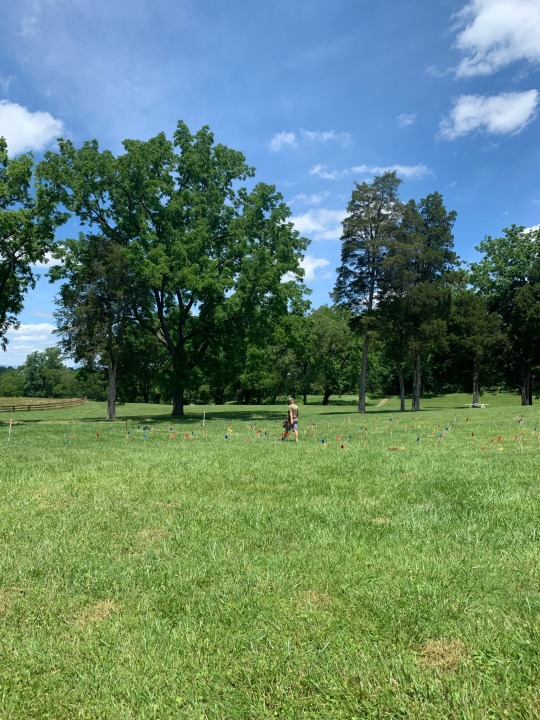
Zeb had a wonderful tour planned out for us by the minute. After our eye-opening discussion with the field school archaeologists at Montpelier, we went back up to the visitors center to start the official tour. We made a pit stop at the gift shop, so Tomi could buy a hat, then we entered the auditorium. Zeb estimated the two videos would be 30 minutes long and he was right on the money. He kept raving over how well done the videos were and how we had to see them. It was hard for us to imagine anything better than Zeb talking to us about the place he knows so well. He was not wrong though, the videos were informative for all ages. Not only were they educational, but they were transformative. Tomi was on the edge of tears during the films because of how well done they were.
The first film spoke about the Montpelier Foundation and what the organization strives to do. Montpelier looks at its vast history from the very beginning. Before it became the estate of James and Dolley Madison, it was the home of Madison’s grandparents, Ambrose and Francis Madison, and then Madison’s parents, James Madison Sr. and Nelly Madison. The history does not stop there. The enslaved community is focused on just as much as the Madison family. Knowing the names of the enslaved, like Paul Jennings, is just as important to the foundation as knowing the Madison’s names. With the slave quarters exhibits outside the main home and the cutting edge archaeological and descendant assisted exhibit, "The Mere Distinction of Colour," shows how much dedication the staff and foundation have to telling every story of the plantation. Nor do they stop there. They do not forget about the Dupont’s who occupied the home for much of the years after the Madisons left. They preserved the home and donated it to the National Trust for Historic Preservation. It is a wonderful place to learn about as they do not cut any corners in accurate representation of history. They recently have taken the large leap of allowing descendants of the enslaved to have power in the foundation with interpretation. This is wonderful news for those in the history community to see oral and ancestral history taking the reins alongside academia and archaeology.
The second mini-film was all about James Madison and his most well-known achievement: the Constitution of the United States of America. It was quirky and animated with features of modern presidents and even Lin-Manuel Miranda from the popular musical Hamilton reprising his role. It went through three major points for why the Constitution is so incredibly important. First, Madison claimed that our country needed factions. Factions are different groups who are interested in their own causes that multiply and level out one another. The diversity of interests would allow the country to survive harmoniously by compromise and the sharing of ideas. The power struggle between small factions would keep power away from one strong faction. Secondly, Madison created the most leveled government ever seen by instilling the concept of checks and balances. Instead of having one strong power as the monarchy, the judicial, legislative and executive branch would keep all leaders in check and balanced. Lastly, Madison was the creator of the Bill of Rights which gives all citizens of the United States undeniable rights that cannot be taken away. Now, we cannot see the unrelenting courage and sacrifice these men were making. Their actions were treasonous against the British Empire, all of the ideas had erupted from an entirely new movement (the Enlightenment), and they were risking it all. Of course, the Constitution and all the founding fathers have their issues. As the video made clear, the Constitution was created to benefit white men and many were slave owners. What makes Montpelier so groundbreaking and evocative is their ability to show all sides of the coin and appreciate legacies simultaneously. The videos were not just hype for the foundation, but reality of what they are doing every day.
After the films, we walked from the visitors center auditorium to the historic house museum. Zeb pointed out many things, like the home’s gorgeous view of the Shenandoah Valley and the symmetric landscape that Jefferson influenced. Once we entered the home, we were filled with nerdy, history student emotion that we were in the home where many of the founding fathers once were. Madison’s home was where the Constitution was toiled over, discussed, and written. We both were having our own “fanboy” and “fangirl” moments by standing in the home. The hallway was filled with paintings that were owned by the three generations of the Madison family. Some were painted as early as the 1500s. We first went through Madison’s mother's chamber, which like all of the home, has original pieces of furniture and ornate wall decor like the mantle and moulding. Thanks to the Dupont family, the original pieces of the home were kept intact. We then moved into the most breathtaking room in the home: the parlor. This is where Dolley Madison’s earliest squeezes would take place and where the founding fathers of our country would meet to discuss the fate of our new nation. We learned about Madison’s road to prominence here. As a young man, he began education early by learning new languages and reading every single book in the home before he was 16. His parents knew that he was something special and wanted him to get the best education possible. William and Mary was where most of his future colleagues were getting their education. His parents saw it as a “party school,” so they sent him to a New Jersey boarding school. This northern school is now known as Princeton University. We were in a room learning about Madison where he once stood with Jefferson, Washington, Franklin, Lafayette, and so many more. It was an experience of a lifetime. Madison’s achievements of being elected to the House of Delegates at only 25, having the influence on George Mason’s Virginia Constitution with freedom of religion, and moving quickly through the ranks of national politics is mindblowing. Madison is a prime example of how education is one of the most important things in life. In the next room, we see a dining table with cardboard guests sitting and one person standing. Zeb tells us Dolley Madison, Lafayette, Madison, and a few more influential guests were seated at the table. “But, sinking back into the walls is Paul Jennings. He saw everything unfold,” said Zeb, about Paul Jennings, the enslaved personal servant to the Madisons. Dolley and James Madison owned 100 slaves and he never freed one person. This is just another great example of the Montpelier Foundation being able to share both of Madison’s legacies. The last few rooms we went through downstairs were Dolley’s bedchamber, Madison’s bedchamber, and his study.

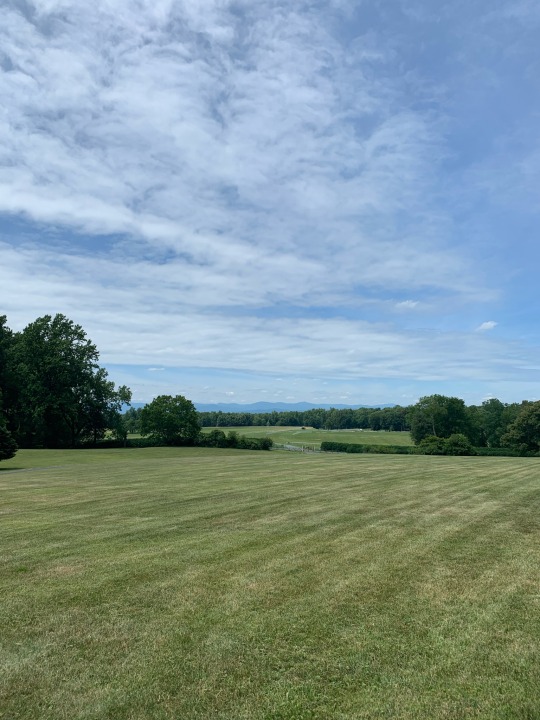
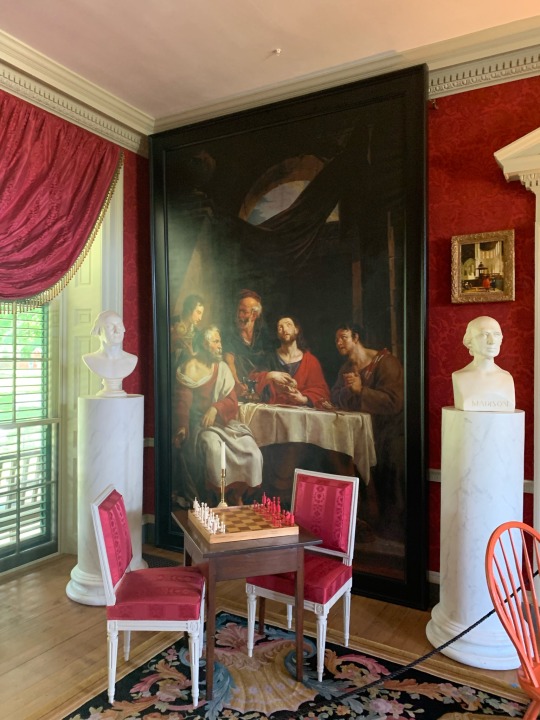
We climbed the grand staircase to see the final rooms of the home. We were able to see John Payne Todd’s room, who was Dolley’s troublesome son, and then the bed chamber of the Madison’s. Dolley and James Madison had this as their room until old age and illness limited the two from climbing the staircase. The room, after their departure to the downstairs, housed many esteemed guests like Thomas Jefferson. The last room upstairs was the most breathtaking room of all - James Madison’s first study where the Constitution was born. Thomas Jefferson sent him over 400 books from Europe for Madison to study in creating the historic document. He read hundreds of books to ensure what he felt was perfection in creating our founding document. With his three revolutionary ideas, factions, checks and balances, and the bill of rights, our Constitution was born. Zeb kindly gave us copies of the Constitution on our way out. He even let us out on the Jeffersonian style porch off of one of the bedrooms upstairs. The view was remarkable! Josh and I were so thankful for Zeb’s captivating and extraordinary tour he gave us through the Madison's home.


Before leaving the grounds, Zeb led the way to show us the final resting place for much of the enslaved community of Montpelier. It took about a ten-minute walk from the visitor’s center for us to reach the cemetery. At first glance, it did not appear that we were standing amongst the graves of an unknown number of people. There was an overgrowth of plant life making it hard to distinguish the site from any other natural trail one might encounter, without the modern signage that is. According to 3-D imagery used by Montpelier today, there are 38 known grave depressions at the marked site, which is just a small portion of the enslaved persons that worked for the Madison family. Other unmarked graves have been found throughout the plantation. Because the original enslaved workers came from Africa to Montpelier in 1723 to wind up in the ownership of Ambrose Madison, the grandfather of James, modern African rituals take place every Juneteenth, as well as on special occasions. The new relationship forged between Montpelier and the descendent community will allow further interpretation and commemoration of the enslaved community. Their stories matter just as much as James and Dolley Madison’s, and it seems that Montpelier is doing everything they can to make this so. After we said our goodbyes to Zeb and fittingly thanked him for one of the highlights of our journey this summer, we made a last stop beyond the main gate. When the Dupont family owned the home, they had a train depot constructed closer to Montpelier in 1910 so they would not have to go as far into town. It is now an exhibit of the historic home next to a modern post office and shows how there were separate ticketing booths - White and “Colored.” Throughout much of the station’s use, segregation was still a part of daily life in the South. Though we were unable to see the interior components of the exhibit because of COVID-19 regulations, we were able to peek in and see how much smaller the “Colored” ticketing booth was when compared to the other. “Separate but equal” was not equal, and we are thankful for Montpelier for sharing this truth.
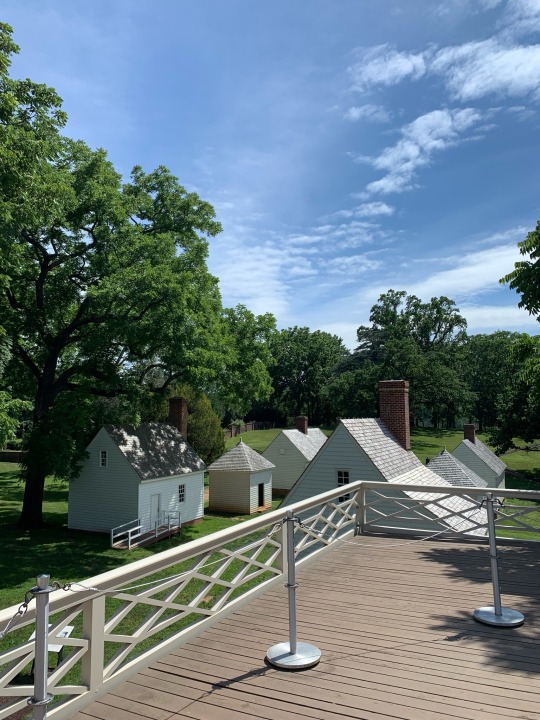
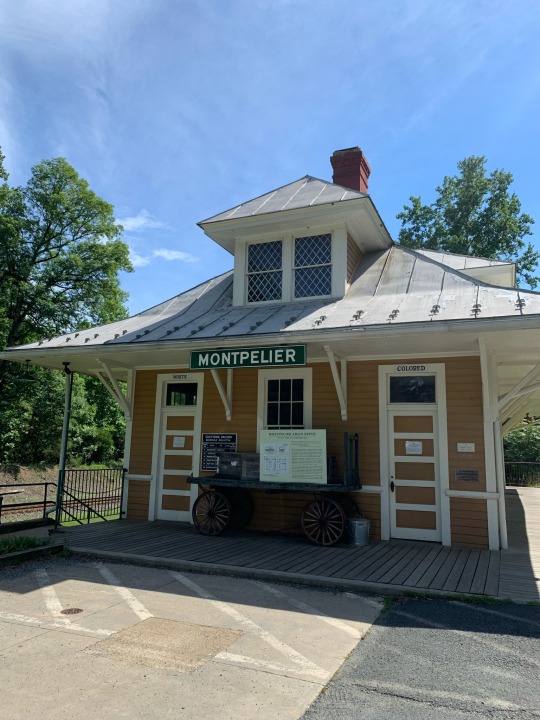
We would just like to give a special thanks to all of the magnificent people at Montpelier who made our tour one of the best we have had all summer. First and foremost Zeb Gray was the best tour guide we both have ever had. The “Z” Tour was one we will never forget. Thank you to the archaeological team: Dr. Mary Furlong-Minkoff, Dennis, Margaret McCormick, Olivia Meoni, and Jennifer McGee for making the experience exceptional. Thank you to Laura Maddox, House Team Leader, who allowed Zeb to give us such a lovely personalized tour. Montpelier was Josh and Tomi’s favorite single-day visit of the summer!
1 note
·
View note
Text
Poplar Forest & Bedford
When we first arrived at Poplar Forest that lies on the outskirts of Lynchburg in Bedford County, we were blown away by the beautiful landscape that surrounded Thomas Jefferson’s retreat. Our team had heard such good things about the historic site from those who work there, our professors, and fellow students, we knew it was a must see spot. When we walked into the visitors center, we were greeted by the most kind staff member that we have encountered at any historic site. He was helpful, sweet, and even asked us about our research. We felt very welcome as soon as we walked through the door. To begin the tour, we started with a fifteen minute video introduction to Poplar Forest. Before the tour began, we realized our tour guide seemed to have little enthusiasm when one man asked her if she was our tour guide and she responded with a flat “yes.” After that odd encounter, we watched the wonderfully done film on Jefferson’s retreat home. The short video captured the stories of Jefferson, the enslaved people who worked there, and the importance of the architecture of the site. We were all looking forward to the tour of the historic home and the rest of our day at Poplar Forest after this.
We began the tour outside of the octagonal mansion with our tour guide explaining the symmetric architecture that Jefferson wanted to experiment with. By combining all of the techniques he had seen in Europe, he created this small, yet grand mansion as his getaway. But, he is not the one who put the physical labor into creating this architectural masterpiece. The enslaved people of Poplar Forest are the real champions of constructing the illustrious home. Our tour guide made that clear when she described much of the back-breaking work the enslaved people, like John Hemings, put into the building. She pointed out the only asymmetric detail, the wing of the home, where the enslaved people spent most of their days cooking, cleaning, and keeping the home the way Jefferson wanted. Unlike other Jefferson designs, there was no other wing to complete the symmetry. As Travis McDonald would explain to us later, “the second wing is the million dollar question.” Speculation from staff who have greatly studied the wing says it was just unnecessary to add another space to the home. We walked a little further to see the newly reconstructed carriage turnaround to what it would have looked like in Jefferson’s day. At Poplar Forest, the staff has taken huge steps to ensure the complete correctness of their rebuilding of the home. Our tour guide made sure we knew this once we entered the home. We were all impressed by the moulding, exact replicas, and specificity of the measurements for the rooms. Not only is the representation of the home wonderfully done, but the interpretation was wonderful. Though our tour guide was a bit quiet and unenthused, she did not refrain from allowing Jefferson to be talked about as human and did not glorify him. She was able to express his architectural genius all the while letting us know he did not build one piece of it. He was wholly dependent on enslaved laborers to have his elitist lifestyle. It was encouraging to see a second site where Jefferson was able to be learned about earnestly and not in a God-like manner. Our tour guide also explained to us in the parlor room how he had a more familial side with his granddaughters who frequently accompanied him at Poplar Forest. In the last room, we got to see the room that mirrored Jefferson's bedroom. While his room was fully restored, this room was used as a progress room to show how the staff at Poplar Forest worked to recreate the Jeffersonian home after it had undergone fire and renovations from other residents. Also in this room was an original John Hemings door. This was a site to see as we all know that he was responsible for most of the ornate mouldings and doors in the original home. We all enjoyed the house tour and were incredibly impressed with all the work the staff at Poplar Forest has done in the short 40 years they have been a museum. In the grand scheme of things, 40 years and starting from scratch is not long for the project that they had ahead of them.

In the basement and the wing of the mansion is an exhibit dedicated to the enslaved workers of Poplar Forest. This was not a part of the house tour, but we made sure to see all that was displayed on our own. We saw the familiar name of John Hemings featured throughout. Without his tireless efforts, the home would not have been able to feature such unique architectural details. Though Thomas Jefferson was a master architect, he was never doing the hard work of actually building what he designed throughout his life. It was enlightening to see what archaeological finds have been discovered at the site. There was one display case that featured a series of items collected by rats in the attic of the home between 1846 and the 1960s, which was far beyond Thomas Jefferson’s ownership of the property. There were fragments of book pages, newspapers, clothes, and more. We walked over to see what was displayed in the wing between the east side of the home and the east mound, and we were amazed to find the kitchen with fireplaces, hearths, and a cook’s quarters. On display in one of the rooms was a letter from Hannah, an enslaved woman, written to Thomas Jefferson. In the letter, she expresses sadness about his inability to visit Poplar Forest that Fall and she also paraphrased the Bible - “we ought to serve and obey his commandments that you may set to win the prize and after glory run.” We believe this letter clearly shows a level of hopelessness and despair within Hannah, but it also depicts a unique dynamic of an enslaved person being allowed the ability to write. This must have been a unique circumstance. We are extremely pleased with the archaeological excavations done to bring the Wing of Offices back to their original form. Past the East mound are structures of the era beyond Thomas Jefferson’s ownership of the property and contained the living quarters of enslaved people during the antebellum era up through emancipation. There was a small exhibit in one of the spaces that allowed further learning about the enslaved. Down the hill and near a modern residential community is a reconstructed enslaved person quarters known as the North Hill site. It was built with logs and had a chimney lined with clay to avoid the spread of fires. A small garden likely existed since food rations were so limited. It was amazing to see the basic shape and size of what the enslaved lived within and is a stark contrast to the extravagance of the mansion. Reconstructing such structures allow sites like Poplar Forest to share the hard, yet necessary, truths of what enslavement looked like.
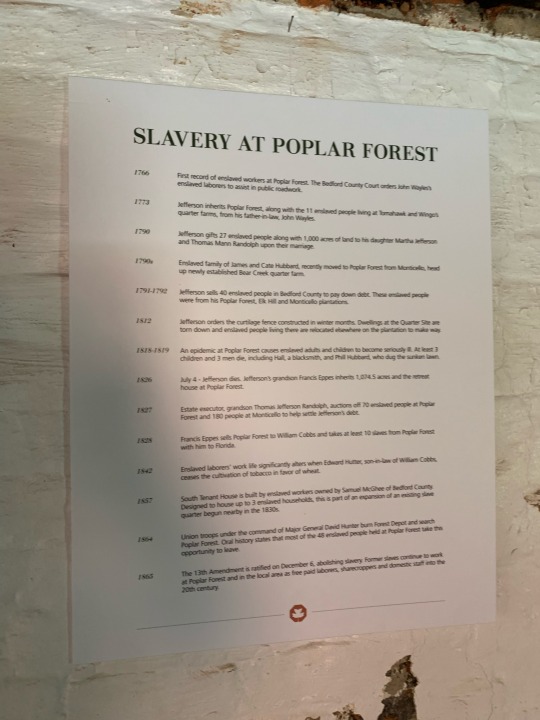

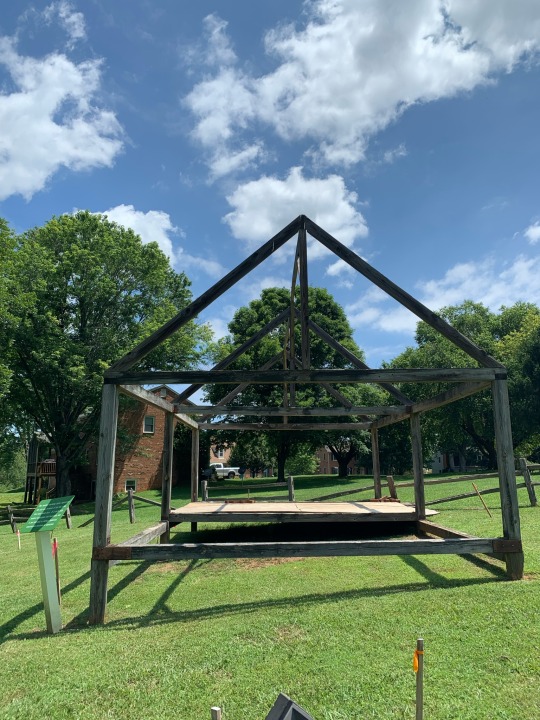

Our last stop after the gift shop at Poplar Forest was to Travis McDonald’s office. McDonald is the Director of Architectural Restoration at Poplar Forest. He has been with the foundation from the very beginning. His skills of being an architect, a restorationist, and a historian in his own right made him the perfect candidate for the position he has held for over 30 years. We were all so thankful that we got the opportunity to speak with him about Jefferson’s historic retreat. As we sat down in his office, the walls were lined with shelves encasing what seemed to be hundreds of books. On his desk and floor there were even more. The books that caught our attention were the Annette Gordon-Reed books, The Hemings of Monticello and Thomas Jefferson and Sally Hemings. His devotion to the ever evolving story of Jefferson was told to us before he even began talking. He told us right off the bat that Poplar forest “strives for historical accuracy over idealistic perceptions.” Since we have been to many historic sites across the state this summer, we have seen a few places that do the opposite. It is so impressive that the foundation has wanted to do this from the very beginning. They have cut no corners in perfection - literally. He explained to us that Jefferson was not the originator of his own ideas, but a master of self-education. He was able to learn and combine many pre-existing cutting edge architectural techniques. From masters of the art like Andrea Palladio, Jefferson was able to utilize his knowledge and European ideas to create his own style. McDonald continued to give us wisdom when he connected his specialty of architecture to history. “Architecture is a lot like history. It gets reinterpreted as new evidence is found and progress can be made.” Our last question for McDonald was about his feelings towards the current issues of Confederate monuments. His answer blew all of us away as it contained sincere emotion and toiled thought. “I had to separate myself from seeing them as art and architecture. As a professional architect and restorationist, that is how I saw and appreciated them for a long time. But now, I have been able to separate myself from that and see what they truly mean.” It was enlightening to hear a professional who has been in his field for decades to share his feelings with us. Travis McDonald was so welcoming and we are so thankful to have had the opportunity to gain insight from him.
We ventured into the small town of Bedford after visiting Poplar Forest. In our earliest research, we found an article on “The War Between the States Museum'' at the Bedford Museum and Genealogical Library. Just from the title, we knew we needed to go see whatever it was. Of course, “the war between the states” is a lost cause term to amplify that states rights was the reason for the Civil War instead of the obvious cause: slavery. We went in and it was a dark, dimly lit place. There were a few staff members and they were kind to us when we asked for admission in the museum. The gift shop was filled with outdated books, old postcards, and Confederate memorabilia, so we gained more insight onto what was ahead in the exhibit spaces. We took what the museum employee called the “slowest elevator in the county” up to the top floor where the exhibit on the “war between the states'' was displayed. We walk in and it is a large room with many glass cases. Again, very dim and not well lit, we strained our eyes to read the exhibits. The first exhibit you see in the space is on “Blacks Service.” All of our mouths dropped. It was an exhibit amplifying the myth of Black Confederates. Yes, Africa Americans served in the Confederacy, but not by their own will. They served as enslaved persons to those in the war. None of us could barely stand to be in the museum any longer after this, but we pushed through. Confederate flags were everywhere, the use of the word “Yankee”, and an exhibit on how Jefferson Davis’ release from prison was “a way to heal the deep divide between the U.S.” was on display. It was mind blowing to see this shrine to the Lost Cause only thirty minutes away from Randolph. At the end of the exhibit, we noticed a little sign on the wall that said the Sons of the Confederate Veterans still meet at least once a month in the room. We were all in disbelief from the complete bias and shrine-like nature of the museum. We traveled downstairs to see the other exhibits on local Native Americans, local African Americans, WWI, and WWII. The Native American exhibit looked like it was a project that the local middle school students put together. The information was not terrible, but the display was embarrassing. The information was presented at an education level for 5th graders, yet there was no signage dictating that it was a children’s exhibit. In the local African American exhibit, there were artifacts from the former all-Black high school, the African American sheriff who just retired, and Carol M. Swain, the African American conservative political science professor and Republican advocate. It was nice to see the information displayed about successful locals, but the message was clear. Overall, the museum experience was subpar. We all knew what we were walking into, but somehow it was worse than we could have imagined. We hope one day that the staff at the Bedford Museum and Genealogical Library will improve their interpretation.




Before we left the town of Bedford, we took a close look at the Confederate monument that stands in front of the Bedford County Courthouse. The text at the base of the high obelisk below a carved battle flag says “Bedford honors her heroes; proudly rejoicing with the living; sincerely mourning the dead. Their history is its brightest pace...This stone is erected to keep fresh in memory the noble deeds of these devoted sons.” Obviously, this monument reeks of the lost cause and does not honor a piece of history that all can be proud of. Taking down such a problematic statue would not be “erasing history,” as Bedford supervisor candidates stated in 2017. The public should play a role in discussions of what to do with the obelisk, but it certainly does not belong in front of such an important government building. Once again, the United Daughters of the Confederacy supported the construction of a heinous monument at a time (1909) when African-Americans faced acts of discrimination and bigotry. If people were able to put themselves in the shoes of those most affected by the presence of such an awful monument, then we would finally be able to make lasting changes for the betterment of us all.

0 notes
Text
Staunton and Sweet Briar College
Last week we drove up Lee-Jackson highway yet again on our way to Staunton. We were all eager to take a bit of a break from our usual Civil War related endeavors to see the Woodrow Wilson Presidential Library and House Museum. One of our good friends also got to come along for the adventure so that added extra fun to the day. The first thing we did was interview Andrew Phillips, the museum's head curator. He has done quite a lot for us two this year. Earlier in the school year, Tomi actually interviewed him for her virtual internship. All of us were excited to meet Andrew in person and talk about the direction of the museum.
Phillips has been at the Presidential Library since 2012. He came into the job without much knowledge of Wilson as he was a trained Civil War historian. Despite seeming like an unlikely candidate for the position, he was exactly what the organization needed. His extensive knowledge of the time when Wilson was in the home and of slavery is something the museum was lacking. Wilson was actually only at the Staunton home for sixteen months, so Phillips decided that it was time to use that to their advantage. His thoughts are that the museum needs to tell the whole story, from birth until the end of his life, with more of a focus on the events of the time he was alive. He did not mince words when he said that “...you will be disappointed when you go downstairs [in the museum].” The exhibits are over twenty years old and the museum has never undergone any renovations to change them. The exhibits are “very nitty gritty on Wilson” and Phillips wants to focus on the pivotal moments within his presidency. Phillips says that the events that happened while Wilson was president were “incredibly consequential” and wants to provide the context for visitors to understand this. By 2026 he and his team wish to overhaul the museum to be a space for education for the important moments that were hallmark to Wilson’s presidency. By expanding the exhibits, the staff can create more in-depth exhibits. Women’s Suffrage, World War I, the Jim Crow Era, and so much more will be covered in more detail than ever before in the museum. The staff at the museum has drive, passion, and ambition to complete these goals, but the only thing they are lacking are the funds. They have applied for multiple grants, but have not received what they need. If you would like to learn more about how to become a member or to help out Phillips and his cause, click here: https://www.woodrowwilson.org/ways-to-give .
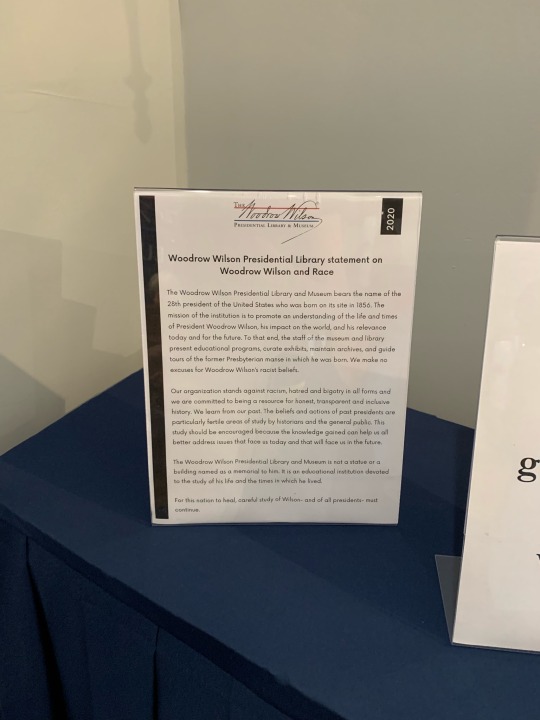
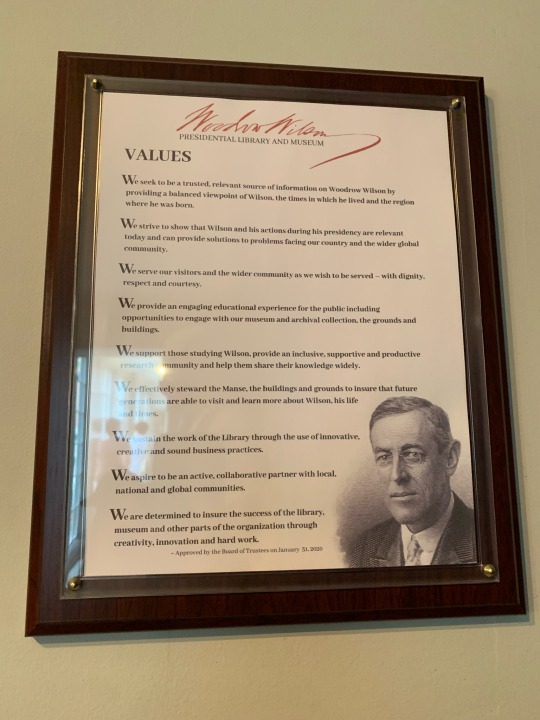
Even though the big steps have yet to be taken, Phillips has already had to make major changes. “When I first got here, in 2012, they were still calling the enslaved people servants. They were misinformed and I had to change that,” he said, speaking of tour guides and how they addressed the enslaved population of Wilson’s first childhood home. The guides were trained initially to use the term “slave” and then later “enslaved person” by Andrew. Phillips said that he and his staff spent at least one year changing this narrative. “The guides wanted to learn and were more than open to the change, but these kinds of things take time.” His next steps are attempting to learn the names of the three leased enslaved people from the church Wilson’s father preached at. “I want to give these people names. We know what they did for the family, but I want to give them their names.” After the tumultuous summer of 2020, he could not stand for the poor exhibit on African Americans to continue to stay up. Phillips claimed that it was “too neutral” and was “sensitive to a position that Civil Rights is bad and showed two sides of the coin.” He and his staff took a huge leap in creating all new signage to create a more honest narrative about how African Americans were treated by the Wilson administration and the country. “We are constantly trying to improve,” said Andrew and we could not agree more. Speaking with Andrew about all the changes that have taken place and that will soon take place was so inspirational. We cannot wait to come back one day to see how much the museum is transformed!
The Woodrow Wilson Museum is an older institution that presents the life and legacy of the man that led the United States during one of the most challenging periods in world history. We first encountered an exhibit that follows Wilson before he became the 28th president. He earned his Ph.D. in political science from Johns Hopkins University before becoming the president of Princeton University, where he incorporated many progressive reforms. He was also governor of New Jersey between 1911 and 1913. We were able to see some reproduced and original artifacts that belonged to Wilson. We were also able to read about his two marriages. He only married Edith Bolling in 1915 after Ellen Axson died in 1914 while he was in office. In the first few rooms, we saw how he campaigned against Republican presidential incumbent, William Howard Taft, and third party candidate, Theodore Roosevelt. As we learned in our interview with Andrew, the museum is no longer misguiding visitors about the actions taken by President Wilson. Though he enacted major reforms like the Revenue Act of 1913 and the Federal Reserve Act, he also allowed segregation to continue within the federal government and throughout the entire country. We saw the newly added yellow Civil Rights panel that did not shy away from being completely frank about Wilson’s personal views. He was a racist man, but again, we saw some pretty consequential things come out of his time in office, such as the passage of the 19th Amendment, which finally gave women the right to vote in elections across the country. This Amendment was only possible after the lobbying of famous suffragists like Lucy Burns, Carrie-Chapman Chatt, as well as the many others that came before them. Though the United States remained neutral through much of the Great War (World War I), we were able to see why and how Wilson convinced Congress to declare war on the Central powers in Europe. The exhibit in the basement about the war was our favorite part of the museum. As the museum mentioned, Wilson was a master negotiator in setting up the Treaty of Versailles and the League of Nations, but the U.S. Congress did not ratify it as Wilson refused a Republican compromise. It was the terms of the Treaty of Versailles that led to the rise of Adolf Hitler in Germany, and the world would yet again enter a deadly conflict only a little more than a decade later. Woodrow Wilson was anything but a decent person that sought equality for all, but we must study his life and presidency at places like the museum and library in Staunton. If we want our country to be better for all Americans, then we must remember and learn from the mistakes of our former leaders. The history within truly matters and we are looking forward to newer interpretation once the anticipated renovations are completed. If you are able, we highly recommend a visit not simply to say you went to a presidential site, but to learn from Wilson’s successes and errors.
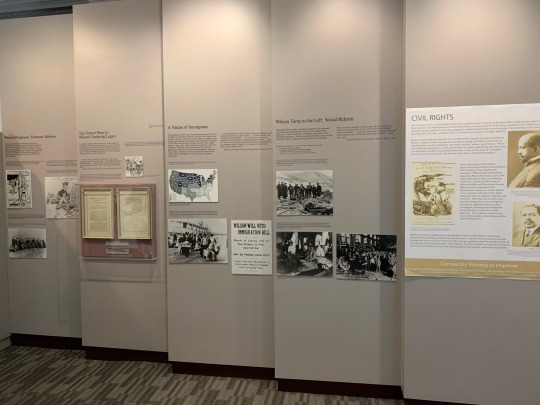
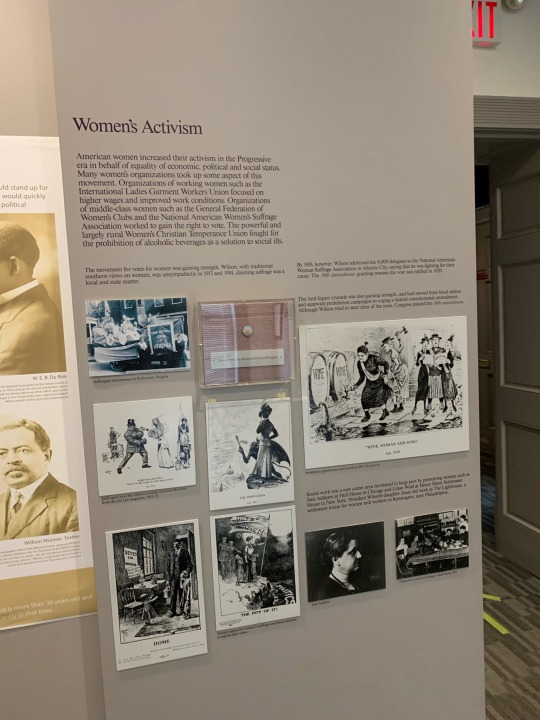
After we walked through much of the museum, we went on a tour of the home where Woodrow Wilson spent the first few months of his life. Joseph Ruggles Wilson and Janet Woodrow started their family in the house known as the Manse in Staunton. The family owned and defended slavery through the end of the Civil War, and Joseph was a Presbyterian minister and chaplain for the Confederacy. Though not much is known about the enslaved persons that worked at the Manse, it does seem that an effort is being made to present what they did in the house while enslaved by the Wilsons. A question was posed by another visitor that was on the tour with us. “What is the difference between saying enslaved person and slave?” The tour guide responded that this was the phrasing that most Virginia museums are using. While this may be true, there is more to it than that. Dr. Sherayko stepped in to offer the whole reasoning behind this choice in language as heard at Monticello and Appomattox. Saying “slave suggests an identity of subservience to others and nothing else. Stating “enslaved person” instead suggests an identity of personhood first, not just the condition they had forced upon them. It is important to understand this shift in language as the stories and personhood of those that were enslaved matter too. We hope that when asked similar questions in the future, the tour guide responds with this explanation. Overall, the house tour was a quality look into a historic home and showed how the Wilson family lived.
On our way back from Staunton, we made a pit stop at Sweet Briar College. The 3,250 acre campus is in the heart of Amherst with beautiful mountain views. We drove all the way back to where their top notch equestrian team practices to see Monument Hill. It is a small cemetery to the founders of the college’s daughter that has expanded to include members of their family and faculty who have passed on. Looking out from this point is an absolutely stunning view of the campus. The tall angel statue for Daisy Williams, founder Indiana Fletcher's daughter, stands tall overlooking the campus as a guardian. We drove around the campus after viewing this solemn, serene area and came across a small cabin in the backyard of the president's home. It is the only surviving slave cabin on the property. What once was the home to enslaved people of the William’s plantation has been used as office spaces, storage, and other uses by the college. But in 2012, with the help of the Virginia Foundation for the Humanities and Lynn Rainville, the cabin was re-interpreted to capture the history of the 170 year old structure. There were signs telling the history with old photographs, maps, and even the names of those who lived in the cabins. The most important piece of signage was the recognition of descendants of those who once lived, worked, and who are buried there today. It was a small, yet powerful exhibit that is worth the visit.

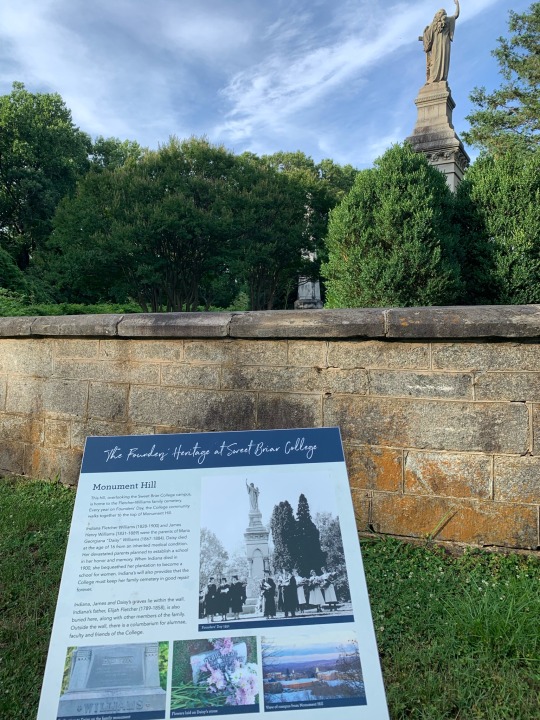
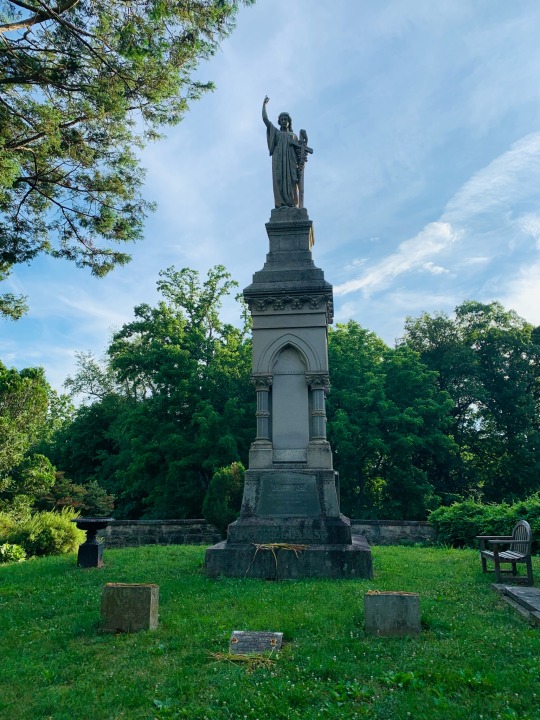
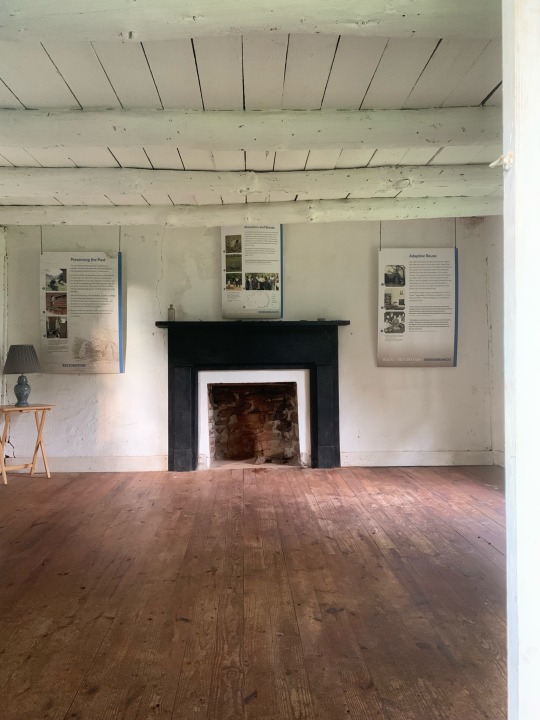
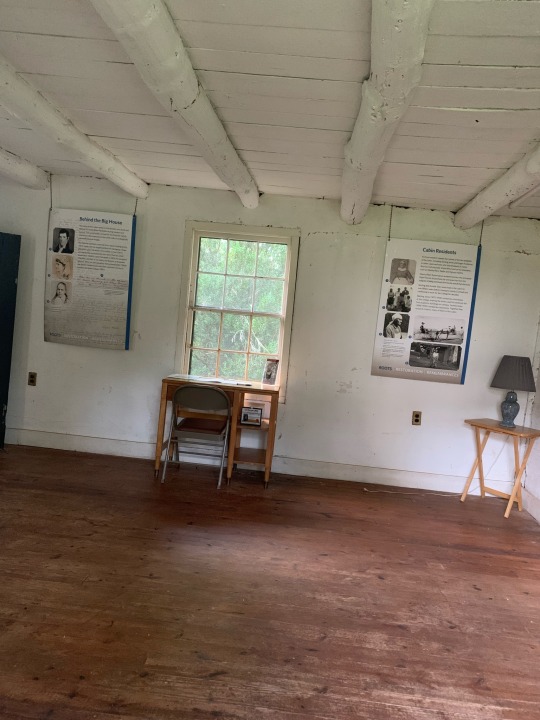
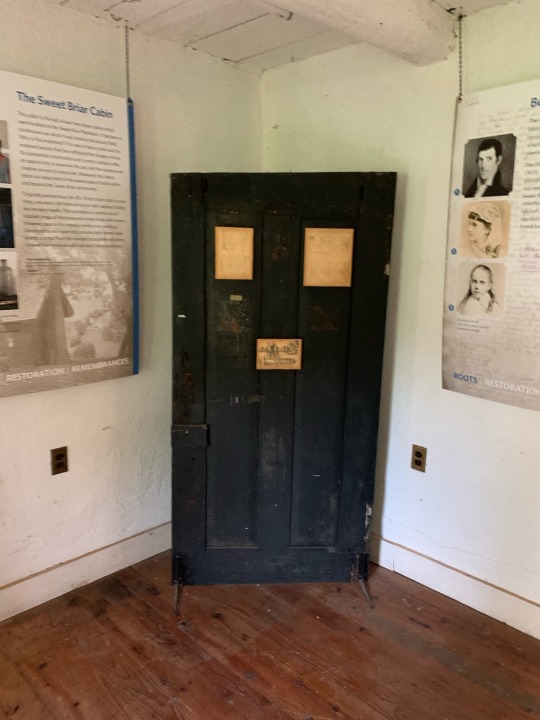
1 note
·
View note
Text
Mount Vernon and Charlottesville (again)
Josh’s Perspective:
I have fond memories of going to Mount Vernon when I was about five years old. I remember it was a chilly autumn night, so there was seasonal hot apple cider available. It was delicious! I do not remember much else though, not even the house tour. The visit during our research would allow me to get a better understanding of what the site continues to maintain about America’s first president. I joined Tomi and Dr. Sherayko in starting with the gift shop before heading up to the museum and mansion only to find many massive school groups gathered. Such a sight would have been unthinkable a few months ago, but it is great to see that people of all ages are getting to go out again. Tomi purchased a few items, but I decided to browse. It was enlightening to see books about Ona (Oney) Judge and other enslaved persons owned by the Washington family alongside material about the founding fathers.
When we entered the museum, we decided to start with the exhibit titled Lives Bound Together: Slavery at Washington’s Mount Vernon. Seeing this felt especially appropriate since we visited on Juneteenth, which celebrates the effective end to American slavery two years after the Emancipation Proclamation was signed. The initial film that we watched set the tone for an honest presentation of George and Martha Washington as slave owners. The inclusion of voices from descendants of the enslaved is an indispensable element of the exhibit as they can tell the story of their ancestors better than any historian can. The material culture presented throughout the dim display cases provides visitors an opportunity to see what life was like for the enslaved community of Mount Vernon. There were a few things that did not seem right to me. At every turn, excuses were floated out for Washington. Yes, he expressed concern for the continuation of chattel slavery in the young nation, but he and his family were still slave owners for his entire life. When one of the panels mentioned that Washington only punished the enslaved when necessary, I got frustrated. Just because punishments were used occasionally does not mean he was good to the enslaved. There is no such thing as a good slave owner. George Washington only freed the enslaved persons that he owned upon his death when he did not need them anymore. For someone that our country holds in such high esteem, Washington was still a slave owner. That is an undeniable fact. I appreciated the narratives presented for famous members of the enslaved community at Mount Vernon, such as Ona Judge, Frank Lee, and Hercules. Their stories matter just as much, if not more, than the people that owned them.

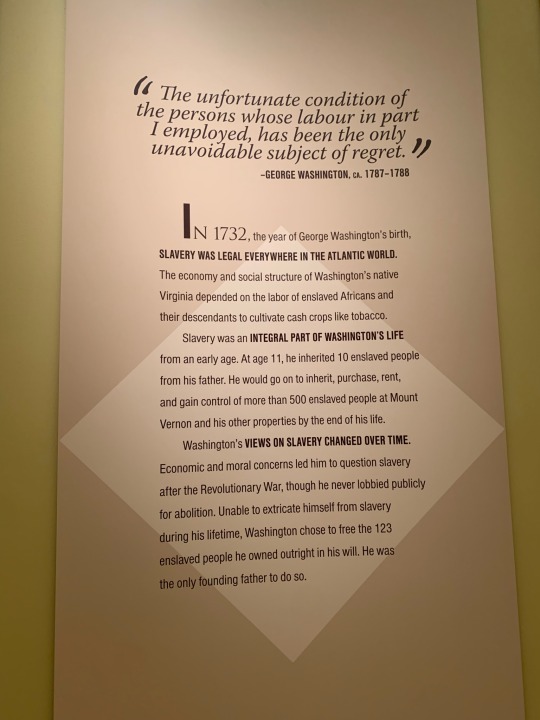
After walking through the next exhibit in the Education Center, which was just a shrine to Washington’s military and political career (including a 4-D film experience), we were all unsettled with what Mount Vernon was doing. Monticello had done a much better job in presenting the full history, flaws and accomplishments, of Thomas Jefferson. We headed down towards the tomb of George Washington and the burial ground for the enslaved. I was glad to see that many people gathered around in the area of the enslaved burial ground. The memorial is located around a marker that was placed in 1929 by the Mount Vernon Ladies Association. Since the language was a bit outdated, a new memorial was placed in 1983. It was designed by students of Howard University. So many stories are unknown about the many people buried in this place, and I wish we could know more. Some laminated cards seemed to be out only for Juneteenth informing visitors about a few of the enslaved, but there needs to be a more permanent piece of signage to respect the memory of all. I did appreciate the member of Mount Vernon’s staff playing solemn music on a fife as we paid our respects.
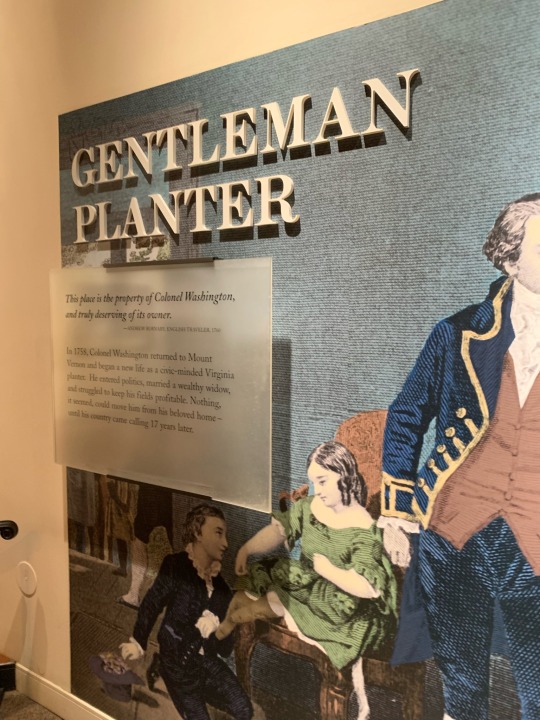
To conclude our visit, we headed back up to the mansion and saw some of the livestock that Mount Vernon cares for along the way. The wait to get inside for the tour took a little longer than any of us were expecting, but we rushed through as soon as we got inside. Some interpreters seemed a bit more knowledgeable than others and the experience was less than satisfactory. There was no real critique of the Washington’s when we were inside the mansion, which needs significant revision. I am not saying that George Washington is on the same level as Jefferson Davis and that we need to remove all statues that were put up in his memory, but we do need to be honest with ourselves. Washington was a man with flaws and his seemingly pristine legacy at Mount Vernon should be complicated. The private organization that owns and interprets the property can do a better job to ensure that everyone can see themselves equally. This may come with serious actions to increase diversity in staff and those that visit.

Though we were all fatigued after the day at Mount Vernon, we made a final stop in Charlottesville before returning to Lynchburg. The George Rogers Clark statue near the University of Virginia is slated to come down later this Summer. The reasoning behind this decision is the depiction of Native Americans. When we saw it in person, I was horrified to see the Native Americans being shown to be subservient and cowering in fear to the explorer on horseback. Colonization had disastrous effects on Native Americans throughout the North American continent. A negative presentation of any tribe or nation does nothing to help the survival of their culture. The University is making the right decision in taking the statue down and discussing a replacement to best honor the culture of the original inhabitants of North America. I am confident that UVA will do the right thing to show that Native Americans anywhere are not cowardly and disappearing people. That kind of monument and education is essential, especially for Virginia groups like the Monacan Indian Nation.
Tomi’s Perspective:
As with most of the sites we have visited, I had not been to Mount Vernon before. I was looking forward to seeing the historic home and museum dedicated to our first president. We entered the gift shop first since we were a little early getting to the site. I picked up quite a few things as I was very impressed with the wide selection of items. My excitement grew after shopping. We walked on a short path to the visitors center and even saw a very cute ram on the way. The funniest part about the whole day was that this little ram would end up being our favorite part of Mount Vernon. The visitors center was packed with guests eager to learn. The staff was kind and pointed us to the maps and audio tour devices. The maps were in a wide array of languages, making the park accessible to a diverse group of visitors. Since I am learning German in the fall and Dr. Sherayko speaks the language, we both picked up one of the German maps for fun. As we were looking where to go, the beginning of our misgivings with Mount Vernon began. The map was not very well done and I got extremely frustrated with this as it was not to scale. Josh and Dr. Sherayko both thought my map frustrations were funny, but by the end of the day we were all feeling that way towards Mount Vernon.
After deciphering the ultra confusing map, we ended up at the museum. We were all very excited to see the Lives Bound Together exhibit on Washington and the enslaved. This exhibit was a breakthrough for the organization as it came out in 2016. It was only supposed to last one year, but the foundation got grants for it to spend extra time in the museum. Once the pandemic hit, the exhibit was extended again. It will finally go on as a travelling exhibit after July 11, 2021. As soon as you walk in you are faced with large panels in a circular room with Washington’s bust in the middle. All of the panels detail the “complex and painful” story of slavery at Mount Vernon. Each of them was honest and told truths about Washington’s slaveholding that had not been shared so explicitly before. One of the hardest hitting facts was that there were over 500 enslaved people at Mount Vernon over Washington’s lifetime. In the beginning here, we noted that it also said he freed his 123 slaves in his will and that he was the only founding father to do so. Though this is true, this fact was unpacked a little more as we went through. The exhibit itself was long and had a lot of reading. This one exhibit was in a space the size of the Tredegar Civil War Museum’s exhibition room. For us, having seen so many different sites over the past few weeks, we know that to truly grasp your typical tourist an exhibit cannot be so long winded. Of course Josh, Dr. Sherayko, and I analyzed the panels as best we could, but even to us it began to be saturated. The worst part was that there was a lot of repetition. It seemed every panel restated something else in different words. Remember back to the fact I shared earlier: Washington freed his 123 slaves in his will and was the only founding father to do so. As we entered the third room, there was yet another panel on the wall about this, but this time there was more to this fact in smaller print than before. Yes, Washington did free his slaves in his will, the ones that he owned himself, but not after his death. In his will his slaves were to be freed at the time of Martha Washington’s death. Mind you, not only did Martha own slaves, but she had over 30 enslaved people she had inherited from her family. Martha owned 153 slaves when Washington died. Why was this mentioned in small print? Just as Josh mentioned our concerns over the extended praise the exhibit was giving to Washington, this was another part that did not sit well with the group. The long, repetitive, overly praising, and not so clear Lives Bound Together exhibit was overall very disappointing. It is wonderful they are talking about the lives of the enslaved and including descendants, but we all feel like the exhibit could have been much better.


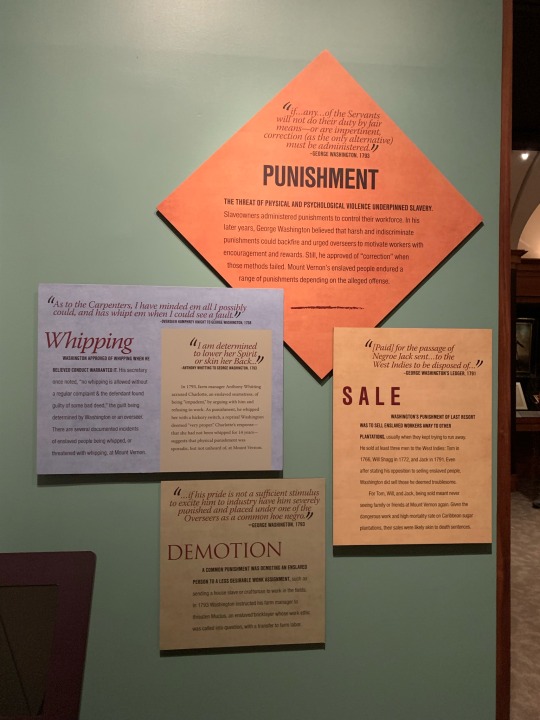
After experiencing Lives Bound Together, we went to the other part of the museum entirely devoted to Washington. Sadly, it was hard for me to enjoy the very patriotic exhibits to Washington. I do believe that we can look at the legacies of our founding fathers and be proud of their brilliance in creating the United States. But, it was very hard for me to do so when there isn’t complete honesty about their slaveholding pasts. When comparing the honesty of Monticello and Montpelier, Mount Vernon was subpar. I wished that I could have enjoyed our 4-D experience, the walk through Revolutionary times, and all of Washington’s history, but I could not.
On our way to the mansion tour, we made a few stops at the enslaved peoples exhibits. These were well done in preserved Slave Quarters. This was enlightening to see after the experience we had in the museum. It was interesting to note that there had once been a store dedicated to Martha Washinton in one of the Slave Quarters. It was still on the map and there was still a sign on the door, but it seemed to have been closed for a while. I wish I would have asked one of our guides why this was changed. We were all happy to see many visitors by the enslaved peoples quarters and learning about their roles at Mount Vernon. After this, we walked to the enslaved people’s burial grounds and to the Washington’s family tomb. Of course it was moving to see the site of our first president's burial, but when we walked over to the enslaved people’s cemetery, we were all moved to near tears. With a flutist playing Amazing Grace and other beautiful songs as we observed the solemn site, we read through some of the stories of those who were buried there. It was powerful to stand where so many men and women that had once been forgotten about, but now remembered by name, had been laid to rest.
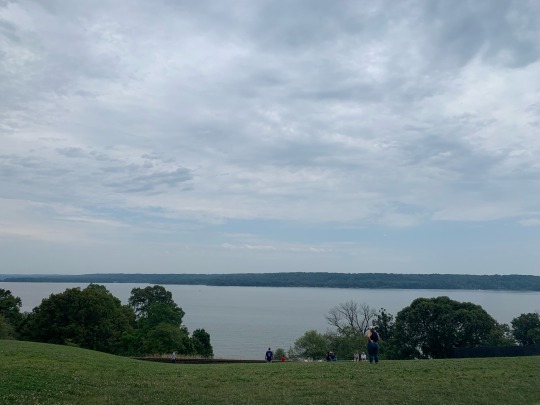
After climbing the hill from the cemetery, we were only 10 minutes away from our house tour. Sadly, they were running very behind and our tour that was supposed to be at 2:10 ended up being at 2:30. During those 30 minutes standing in the heat, Dr. Sherayko filled the time by teaching us new German words like enttäuscht. The house tour only lasted 15 minutes and was quite an odd experience. In the first room, our tour guide slipped up and used the word “servant” to describe the enslaved population. In the end she corrected herself, but that shows where Mount Vernon’s interpretation has been. Going through the home quickly, seeing the horrid green paint on one of the walls that was said to be Washington’s favorite, and then to end with a really odd tour guide sealed the deal for us to head home from Mount Vernon.

On our way out we stopped by the new Ona Judge National Historic Sign. I was beautifully done and we were so happy to end such an up and down day at Mount Vernon on such a high note. Josh and I were happy to end our trip smiling together in front of this wonderful sign.
Despite all of us being deliriously tired, we made a pit stop in Charlottesville to hit Trader Joe's and grab dinner. At dinner Dr. Sherayko reminded us of a statue we forgot to see on The Corner at UVA that is due for removal. Even though we were all spent, we made the trip. The statue of Revolutionary War hero George Rogers Clark does little to show his heroism. He is best known for defeating the British in quite a few battles and earning the French’s trust, but he also has another legacy that is shown in the monument to him. “CONQUEROR OF THE WEST” is the title given to Clark as he sits on his horse, reaching for a weapon to use against Native Americans. Clark fought and took Native American land in many battles. After the Revolution he was even given the position as Indian Commissioner. Though this statue may accurately represent one of his legacies, it puts it in a celebratory light. Celebrating the destruction of indigenous peoples lands, people, and assets is nothing to be proud of and have a statue for. We are all quite happy UVA is choosing to take this statue down.
After grabbing some delicious ice cream at Kilwins, we randomly saw Dr. d’Entremont, our American History professor, walking across the street. I embarrassingly stuck my head out of the window and called out to him. We pulled over and chatted about what we all were doing in Charlottesville. He mentioned to us another site we should check out that is actually no longer there anymore. There was a Confederate statue on the courthouse lawn that was removed last summer. There isn’t even a base left, so in our initial trip we would have had no idea to look for it. We all mosied up the street together and looked where the old statue used to be. We ran into a resident of apartment buildings right across the street who expressed fond memories of the old statue, the Lee statue that was only a few blocks away, and the Clark statue. She told us about walks along this street with families, how there would be a live nativity scene at Lee Park, and how her fathers law office was right across from the Clark statue. She understood mostly why they were being taken down, she said, but she felt like it robbed her of childhood memories. We all listened to her touching story, but what she may not understand is that there is a significant population of African Americans and other citizens who are unable to have such fond memories. These statues that are entrenched in the Lost Cause and have racist sentiments leaving the monument landscape allow for a more inclusive community where all can create similar memories to hers.
2 notes
·
View notes
Text
Washington D.C. Day 3
One would think after spending a long day in Alexandria, our research group would be satisfied. Of course, as always, there is more to see when you are as eager as we are. None of us had ever heard of this monument until the fall semester when a fellow classmate of ours did a project on it with its corresponding museum. The African American Civil War Museum is right outside of Chinatown and in the heart of a thriving African American neighborhood in DC. Their mission is to “preserve and tell the stories of the United States Colored Troops involvement in the Civil War.” The organization tells the stories of the over 200,000 African Americans who fought to keep the Union together and end the institution of slavery. Sadly, the museum is closed due to COVID-19, but will open if there is a scheduled appointment in advance. We did not realize that we needed an appointment, so we only got to see the memorial outside. The monument honors the service and sacrifice the African American soldiers made to fight for a country that had never once fought for them. The risk of fighting in the US Army was more than losing a life. If you lived to see the Union reunified, would the country they were fighting for finally support you in the end? Their bravery to fight for the union and trust in the United States is unparalleled to any other group of soldiers in U.S. history. The front of the monument depicts four African American soldiers gazing ahead, guns in hand, standing tall with confidence. Behind them on the backside, shows what sculptor Ed Hamilton called “Spirit of Freedom.” It is a soldier surrounded by his two children, mother, father, and his wife, seeing them off before he goes into battle. It is a scene that has been created many times, but not for people of color, especially in the Civil War. The hard work of African Americans in the Civil War will no longer be overlooked thanks to the African American Civil War Museum and this remarkable monument
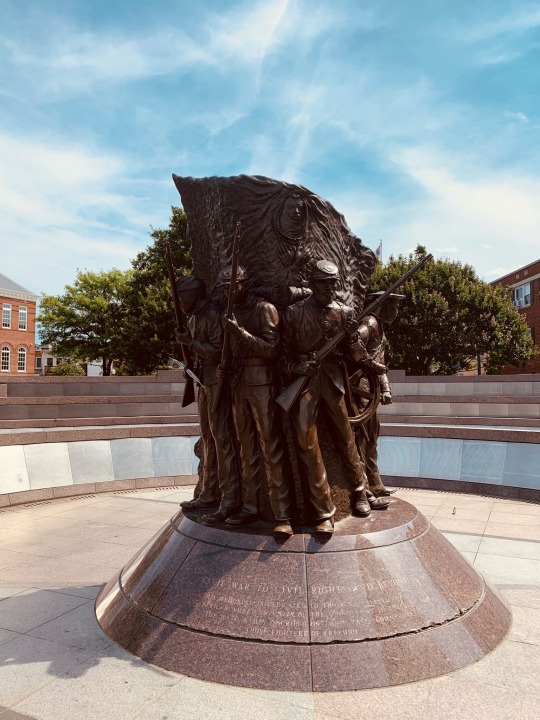
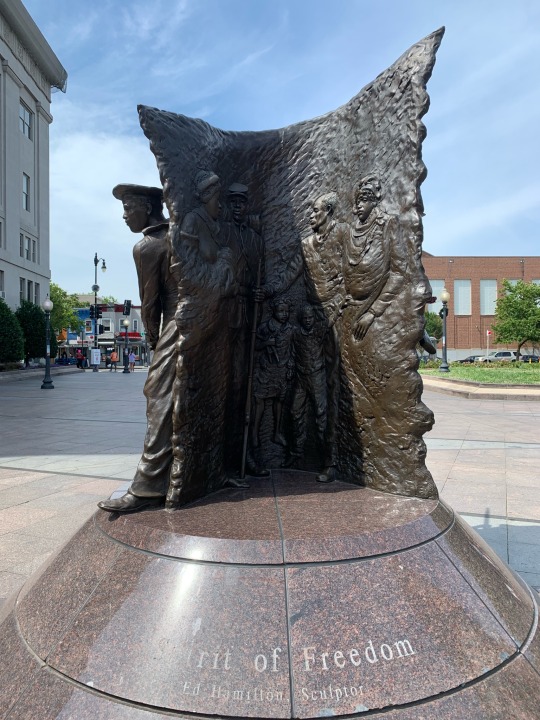

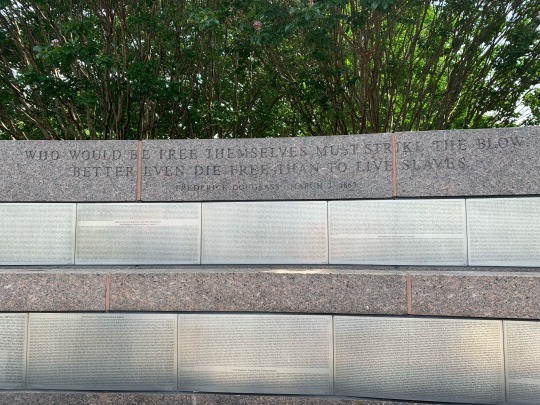
Though we had walked well over 10 miles by the time we sat down for dinner, we found enough energy within ourselves to visit the Japanese American Memorial to Patriotism During World War II located north of the U.S. Capitol. Constructed in 2000, the memorial is honest about Japanese and Japanese Americans that were sent to internment camps during World War II based solely on their race, not on any acts of spying or espionage against the United States. The sun had gone down as we reached Union Station, so we expected the site to have bright lights. We were unfortunately disappointed as many lights were dim, broken, or not functioning. There was also a water fountain component that appeared unused for a long time. We had to use our phone flashlights to be able to read the inscriptions. On the edge are the words of President Ronald Reagan, who signed the Civil Liberties Act of 1988 giving monetary reparations to families that were interred at the several camps around the United States. The rear wall lists the locations of all camps and how many people were sent to them. In total, over 120,000 people were forced from their homes in the western states of the mainland and Hawaii. We previously read They Called Us Enemy by George Takei, an actor who spent a portion of his youth at the Rohwer camp in Arkansas. Upon reflection, we can see how great of an error it was for President Franklin D. Roosevelt to violate human rights when he signed Executive Order 9066. The attack on Pearl Harbor caused fear to impact American domestic policy, but families that did not have anything to do with the attack should not have been forced from their homes. The structure in the center depicts Japanese cranes with barbed wire in their mouths. This striking symbolism shows how unjust internment was. Faith in the United States did not waver for some Japanese Americans, as proven by the inscribed words of Norman Y. Mineta. "May this memorial be a tribute to the indomitable spirit of a citizenry in World War II who remained steadfast in their faith in our democratic system." This memorial should be a lesson to all about the negative ramifications of fearing others based on race. All Americans deserve safety and respect regardless of where they come from. We only wish the memorial was maintained better for all to enjoy throughout all hours of the day.


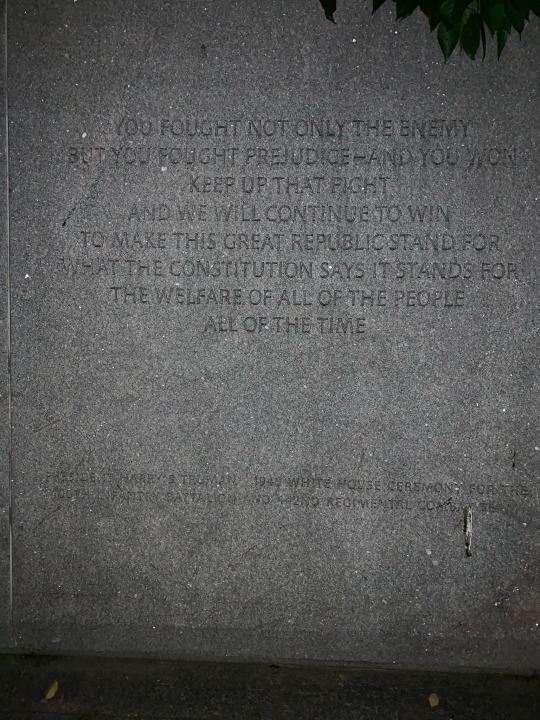


0 notes
Text
Alexandria, VA
After a quick bite for breakfast at our hotel, we took the Metro to head over to Alexandria. We wanted to stop at sites related to African-American history that Rebecca Grawl, the Lincoln assassination tour guide, informed us about. We set out to visit them all on our third day in the area. The first stop was a quick walk over to the site of the Freedom House Museum and the Shiloh Baptist Church. According to the historical sign, the latter was originally a place for free African-Americans to find refuge. A historically Black congregation has flourished at the West Street church and has hosted prominent visitors like Representative John Mercer Langston, Dr. Dorothy Height, and President George W. Bush. Close to the site of this church is the Freedom House Museum, which was once the headquarters for one of the largest slave-trading companies in the entire country, Franklin and Armfield. The company's owners held enslaved persons in pens before shipping the majority South to places like Louisiana and Mississippi, where they could charge for higher prices as the demand for enslaved laborers was high. Until 1861, the brick building that each of us stood in front of was owned by slave trading companies. Though the Freedom Museum is currently closed, they have an important role in sharing experiences from the enslaved that were in Alexandria. These two sites show the progress that has been made in developing better opportunities and experiences, but one also shows the constant presence of a painful past that takes decades to unravel. Getting in touch and learning from that past is possible for all citizens with the Freedom House.


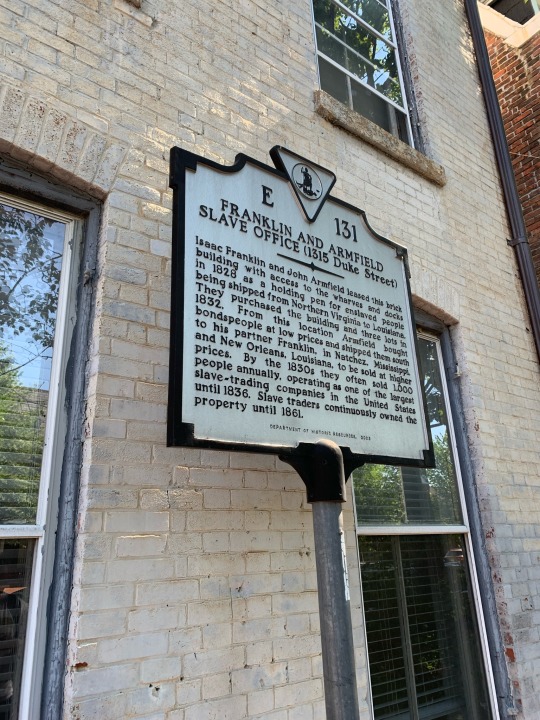
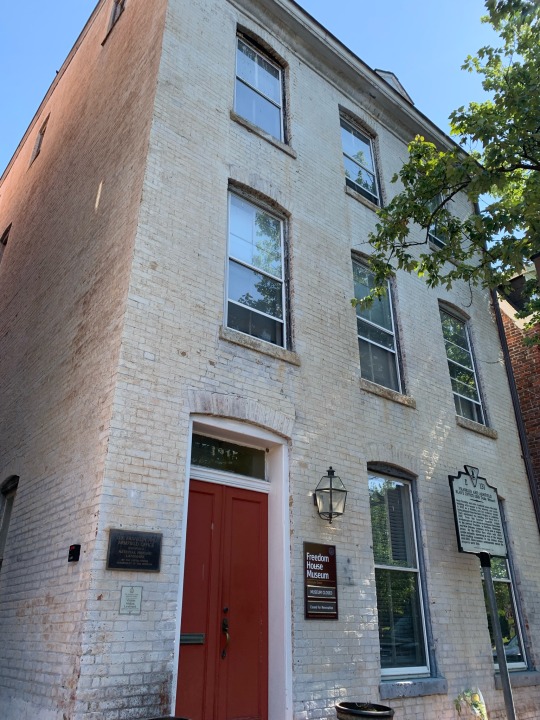
After a long walk, we had finally reached the site we all had been anticipating most for our trip to Alexandria: The Contraband and Freedmen Memorial. As soon as you walk up to the cemetery, you see the sidewalk has different colored bricks. This symbolizes graves of freed African American men, women, and children under each tan brick. This alone struck a tear from each of us. We all knew this was going to be a difficult monument to grasp. You walk into the gates of the cemetery to see two graves that have created life size interpretations of coffins for an adult and child. The cemetery was dedicated in 1864 by the Union forces for freed African Americans in the area. Due to the amount of enslaved people making the journey to freedom, many had poor health from living conditions, prior treatment, and the journey alone. The cemetery was for those people in this area. Soon after the war ended, the cemetery was abandoned. Over 1,700 people are buried here, but their graves would not be respected or acknowledged again for over one hundred years. On the site, there was once a gas station and office building that desecrated the grounds. The same cement floor that once was the gas station’s floor is still there to house the monument. The archaeologists worried removing it would disturb and destroy too many graves. It is hard to imagine 20th and 21st century people coming and going to fill up their tanks where so many people were laid to rest. Of course those who constructed both buildings cannot be blamed as they most likely had no idea. There are likely more sites like this to be discovered throughout the country. As you go further into the memorial, you see a grand statue titled The Path of Thorns and Roses that breathtakingly details the struggle and triumph of African Americans. On cement panels, the memorial describes life in the area for newly freed slaves. Education, shelter, family, and work are all discussed. One of the most touching pieces of the memorial are the small additions besides names of those buried that say: “Living Descendant Found.” This is encouraging to know that these people who fought for freedom still have survivors today. This memorials' location can describe the perspective for many Americans who do not understand why African American and enslaved peoples history is so important to learn about and is increasingly being discussed. Directly across the street there is a white cemetery that is still used from the 18th century. How does one survive but another doesn’t when both hold free, American citizens? The cemetery was long forgotten about, along with so many other pieces of history that our white ancestors felt were not important, all because of the skin color of those who were buried. This is the case for many “hidden histories'' across our great nation that are finally being told today. We are so thankful that today we are in a place where not only can we learn one side of history, but now we are able to see everyone's side.
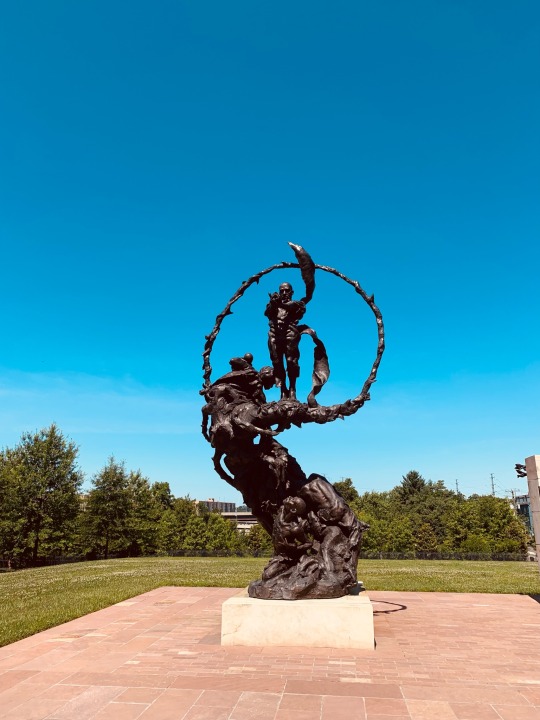
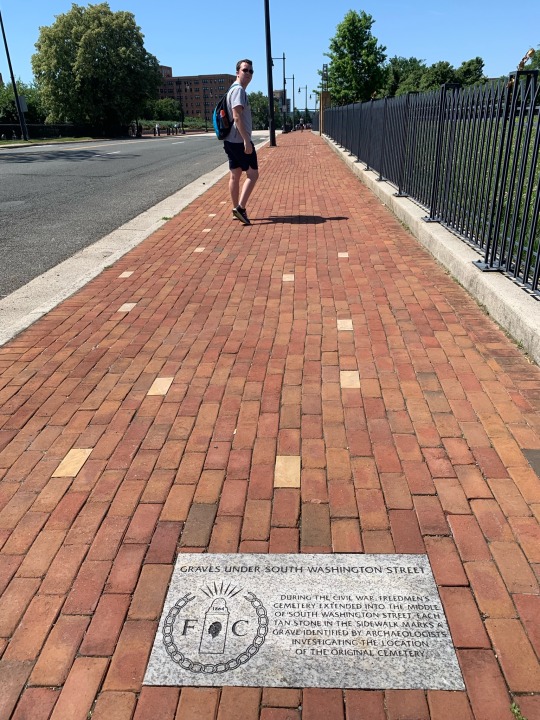
On our way to see the relatively new Loving v. Virginia signage, we encountered another place of worship called the Beulah Baptist Church. We learned from the church’s historical marker that many freed enslaved people sought out the First Select Colored School led by Rev. Clement “Clem” Robinson beginning in 1862. Morning and evening classes were packed with African-Americans seeking a quality education. When the Union began to occupy Alexandria, the Beulah Baptist Church congregation was the first African-American church in the city. Education was central to Beulah’s cause ever since it was set up in the neighborhood. We were trying to find the Loving v. Virginia signage for about 10 minutes before finally locating it on a lightpost. It details the Law Office of Cohen, Hirschkop, and Hall that was located at 110 N. Royal Street. Richard Loving famously told his lawyer fighting Virginia’s ban against interracial marriage to “tell the court I love my wife and it is just unfair that I can’t live with her in Virginia.” Richard and Mildred won their case and similar interracial marriage laws were struck down acorss the entire country after the Supreme Court weighed in. Both places are incredibly meaningful and deserve to be remembered in Virginia.
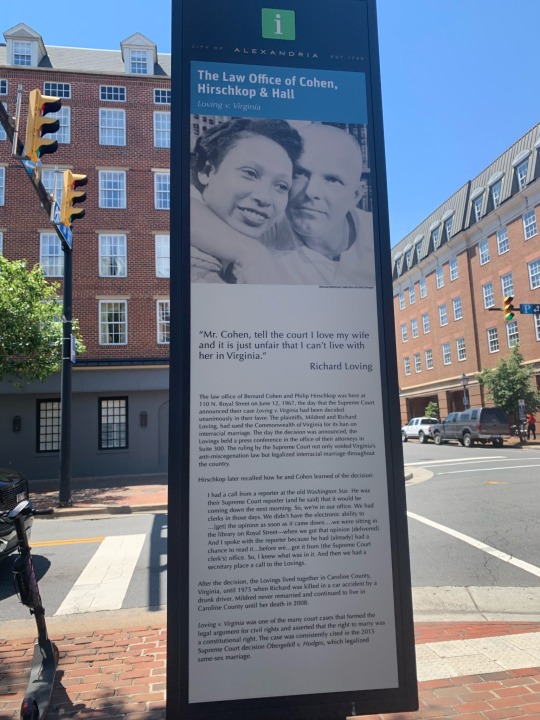


Alexandria was full of Easter eggs for us history buffs. On the way to the Alexandria Library, we were shocked to see yet another historic African American Church. The Roberts Memorial United Methodist Church began in 1834 with prominent members of African American society that attended. The church's congregation was originally a part of the white Trinity Methodist Episcopal Church, but founded their own congregation and created a space for worship. Not only were they a church, but also offered basic academic education in their Sunday School lessons. Notable visitors to the church were Booker T. Washington and Frederick Douglass. We were all very excited when we came across this important site. Next, we were able to visit the Alexandria Library to see the memorial plaque to the 1939 sit in. Five young African American men walked into the whites-only library and requested library cards. When William Evans, Edward Gaddie, Morris Murray, Clarence Strange, and Otto Tucker were rejected, they sat down and began to read. Their peaceful resistance was barely recognized. Instead of integrating services, the city constructed a separate library space called the Robert H. Robinson Library in 1940. In the wake of Civil Rights protests, the library system only began desegregating in 1959. Thankfully, the young men’s efforts are now recognized on this plaque and in the old African American Library, now a museum.
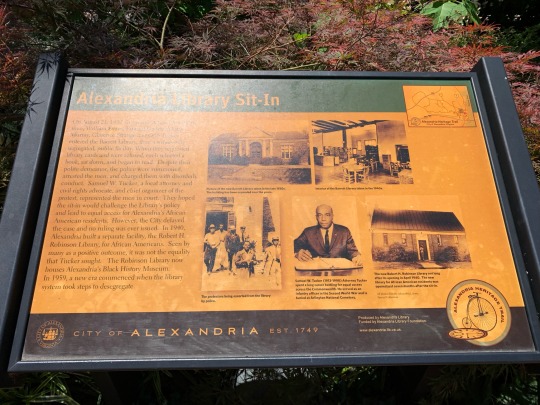
Though we did not mean to encounter the burial site of at least 30 Confederate soldiers at Christ Church on Washington Street, we did when on our way to our last stop. The engraved stone marker that indicates this was erected in 2002. They were disinterred from the Alexandria Soldiers Cemetery to be placed at their current resting place. Interestingly enough, a Black Lives Matter sign is hung on the fence right next to where the marker sits. It is remarkable to see how quickly the values of the City of Alexandria and its residents have shifted. We saw Pride flags and progressive signs throughout our walk through the area. The Confederate marker just seemed out of place. While the graves should likely not be moved, balance and context are the best way to address their presence. This exists with the placement of the BLM sign. It is not actively disrespecting those that died. It simply allows all to feel welcome at the church and see themselves represented in their values.
Our last stop in Alexandria was at the Edmonson Sisters Statue. Mary and Emily Edmonson were due to be sold in the notorious slave block in Alexandria owned by Joseph Bruin. The sisters, alongside 75 other enslaved people, attempted a rebellion and escape on the slave ship Pearl. Sadly though, the attempt failed and the ship arrived in Alexandria. The fate of many of the enslaved people would be to go deeper south, but thankfully for Mary and Emily, their lives took a different turn. Though the sisters were bought by Bruin and destined for a horrific fate in the deep south, the work of abolitionists changed their lives forever. Abolitionists raised enough money to buy the sisters freedom and allow them both to live a free, happy life. It is stories of triumph like these that allow for all Americans to see the heroism and bravery of our ancestors before us.
#alexandria#va#monument#history#enslaved people#cemetery#loving v. virginia#memorials#edmonson sister
0 notes
Text
Washington D.C: Day 2 at Arlington and Lafayette Park
Day 2 began with a trip to Arlington Cemetery. Before going through the cemetery itself, we went to the NPS Arlington House: The Robert E. Lee Memorial. If we were all being honest with ourselves, our expectations for the historic home and grounds were not very high. Neither of us had ever been to the home that once belonged to Lee due to the site being under construction. Both of us were wonderfully surprised by the progressive and honest programming the National Park Service site had. So far, it has turned out to be Tomi’s favorite. We got off the trolley to be greeted by a sign that read “Division and Reunification” which offered a small background on the site and a map of the area. We reached the historic home thirty minutes before our scheduled tour, so we decided to explore the grounds.
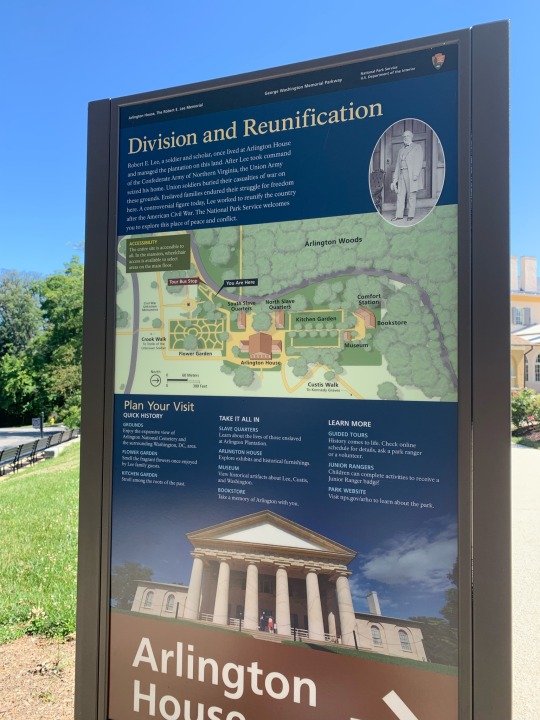
First, we went into the museum. We were all blown away. The first thing you see is a lifesize statue of Lee in the center of the room, but right beside him, there is signage that reads “A Place of Division and Reunification,” just like we had seen in the beginning. We then sat down to watch a short film on Arlington House. It was phenomenal. The film asked questions to spark interest and encourage questions about the site, as well as how history is interpreted about those who lived and worked at the Arlington House. The museum only got better as we continued through the small space. Along the walls in glass cases were artifacts and panels that spoke about the facts that can only be traced in documentation or by DNA. You could trace the Custis family tree and see the descendants of the enslaved people as well. The NPS left no one out of the interpretation. Finally, what caught our attention most were the interactive physical and digital polling centers. On the wall were five important questions for visitors to answer on sticky notes and think about through their tour: How should we tell the story of Robert E. Lee? How should the United States remember those who fought for the Confederacy? How do the beliefs of your friends and family shape your own views? How do you balance your family, loyalty to your home, and loyalty to your country? How do the actions taken by Lee and other former Confederates continue to impact the nation today? All of these questions had quite diverse answers as one could imagine. Asking visitors these tough questions, whether they physically answer them or not, creates conversation and thought. On our way out, we noticed a small interactive piece of the exhibit which asked you opinion questions pertaining to the museum and showed you the answers of others. It did not shy away from any hard topic and allowed for a visitor to really contemplate and think about what they had seen in the museum. The rest of the tour only got better and we even returned to the museum at the end for a second run through.
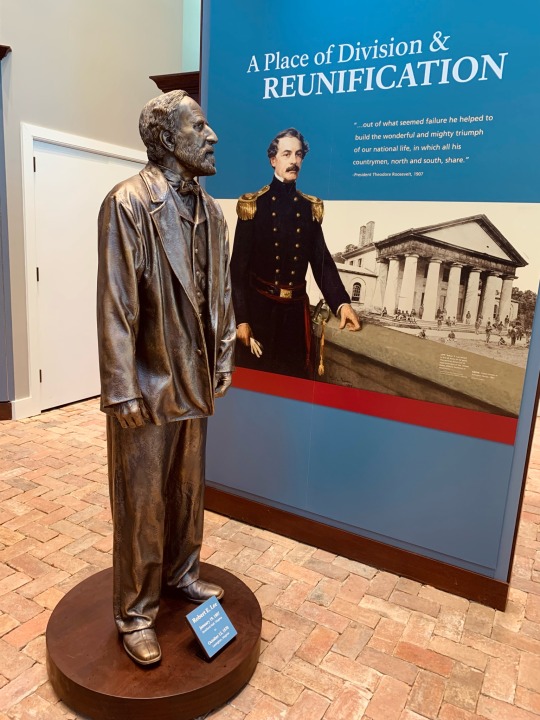

As you enter the home of the Custis-Lee family, the first room you enter is Lee’s office where he spent most of his days in his short, four year residence at the Arlington House. It is curious to us how the home was so Lee focused in the past, as he was the shortest resident in the home. This is one of the reasons why the National Park Service is actually considering dropping Lee’s name from the site. Back to the office, this space has importance because not only did Lee spend a lot of time here, but this is also where he declined to command and continue to serve in the US Army on April 20, 1861. Continuing through the home, it was not a shrine to Lee, but a wider focus on all who lived there. We saw paintings in the parlor by George Washington Parke-Custis, the original owner and builder of the home and also about the life of his daughter and Lee’s wife, Mary Anna Randolph Custis Lee. The home acknowledges how Mary Lee was the actual sole owner of the property and her father instilled many legal barriers to ensure her husband would never have ownership. This was something that rarely happened in the 19th century where the father entrusted their daughter more than her husband. Finally, you are able to view the large dining room that had once held many famous guests. When viewing the dining room, there was a type of interactive question the museum posed to us asking, “If you could have a dinner party, who would you invite?” Although this question is not nearly as hard hitting and involved as the others, it shows interpreters wanted to keep asking questions for further thought throughout the experience. Due to the pandemic that still clouds our lives, the small upstairs and basement areas are not able to be toured physically, but can be seen on an interactive exhibit. Overall, to be a house museum, the tour told a visitor more information than the type of china on the table. We were able to see personal sides of the Custis-Lee home that none of us had experienced before.
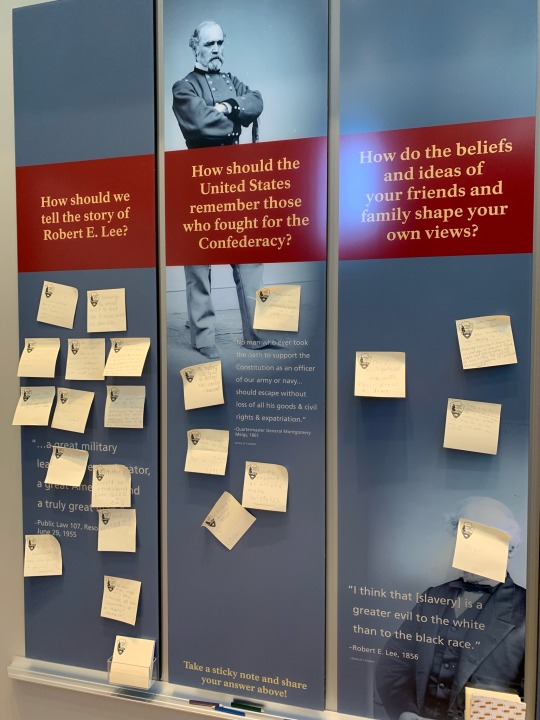
Our last tour we took was through the north and south slave quarters on the property. Dr. Sherayko was positive that these spaces were not a part of his last visit to the site decades ago. We asked the kind National Park Service ranger what those buildings were used for before being interpreted correctly as the slave quarters. After the experience we had at the Appomattox Courthouse and how they had restrooms styled as slave quarters, we wondered about what these had once been. “Those buildings are original slave quarters. They both were gift shops for the Arlington House prior to the renovations. Now they are brought back to their original state and have exhibits on the enslaved population.” We all walked away astonished. Gift shops? Restrooms? It is absolutely incredible how far the NPS has come to correct their past mistakes and correctly interpret the history of their sites. Entering the dwellings of what could have been for many of the 196 enslaved people at the Arlington House was a powerful experience. Their names, their stories, and their descendants still live on today for all visitors to see. Through thoughtful programming you are able to see bedrooms, the kitchen, and other spaces to grasp what it was like for the enslaved community at the plantation. We were also pleasantly surprised to see a brochure in the quarters that spoke on how Arlington House wished to move forward as a “place of dialogue.” A photo of this brochure is attached. Not only were the exhibits limited to talking about the enslaved people on the property, but also the Freedman’s Village that grew to over 1,500 residents after the Civil War. One of the men, James Parks, who lived, worked, was freed on, and passed away on Arlington House land is actually buried in Arlington Cemetery and was with full military honors. With these added exhibits the Arlington House finally tells the whole story of the plantation, not just half of it.
We all had visited Arlington Cemetery several times throughout our lives. It is a somber place that is still very much active with dozens of military burials every day. Stops that all visitors should visit include the Kennedy gravesite with the eternal flame and the Tomb of the Unknown. Ted Kennedy, a powerful presence in the Senate for years, was the most recent family member to join the others at Arlington in 2009 and each of us paid our respects There are several locations along the tour tram route where the grave markers seem to go on forever showing the true cost of keeping our nation free. Adjacent to the Kennedys is an area reserved for some notable Supreme Court justices, including Justice Thurgood Marshall and Chief Justice Earl Warren. Justice Ruth Bader Ginsburg, who passed away in 2020, was recently buried next to her husband. Following the traditions of her Jewish faith, her name will not be added to the gravestone until a year after her death. Though she was petite in stature, her impact on American law was enormous. It was important for all of us to honor her. Medgar Evers was a lesser-known gravesite that we learned about from Dr. Sherayko and the tour guide. We had to pay our respects to the World War II veteran that was also a civil rights activist from Mississippi. As the Mississippi State Secretary for the NAACP, he challenged state-sponsored segregation at the University of Mississippi and worked tirelessly for the voting rights of African-Americans. Unfortunately, Evers was assassinated in his own driveway in 1963 by a white supremacist apart of a group called the White Citizens Council. He was incredibly brave in his service during his years as a member of the Army and an activist for what is right. Evers was able to be buried at Arlington with full military honors. The last site we saw while at Arlington Cemetery was the Confederate monument constructed in 1914 by the United Daughters of the Confederacy. It went up to honor the 482 Confederate dead buried at Arlington. As seen in our previous posts, everything that the United Daughters of the Confederacy has touched seems to be controversial, and this monument was no exception. It depicted a Black Confederate soldier and a mammy figure that appeared willing to support the Southern cause. Though the artistic style of Moses Ezekiel is impressive, the monument does little in telling the truth about what the Confederacy was fighting for. If its sole purpose recognized that Confederate soldiers are buried at Arlington, no issues would exist. However, since it is shrouded by the Lost Cause, it needs significant actions for context or should be considered for removal.

Our final stop at Arlington Cemetery was the Women In Military Service For America Memorial and Museum. A beautiful structure that commemorates the loyalty, honor, and sacrifice women in our armed services have made and continues to make for our country. A peaceful fountain shoots water upward as the monument to servicewomen surrounds the water feature. Inside the grandiose structure is a museum detailing the efforts of women from the very beginning of their ability to serve. Not only are there original artifacts like uniforms, letters, and weaponry, but there are also notable service members who are recognized with their own personal stories and achievements. To continue the peaceful environment felt outside the museum, art cascades the walls of the museum by service women. It was an inspiring piece of the Arlington landscape none of us had ever been in. We are all thankful we took the time to learn about, appreciate, and honor servicewomen by attending the museum and memorial.
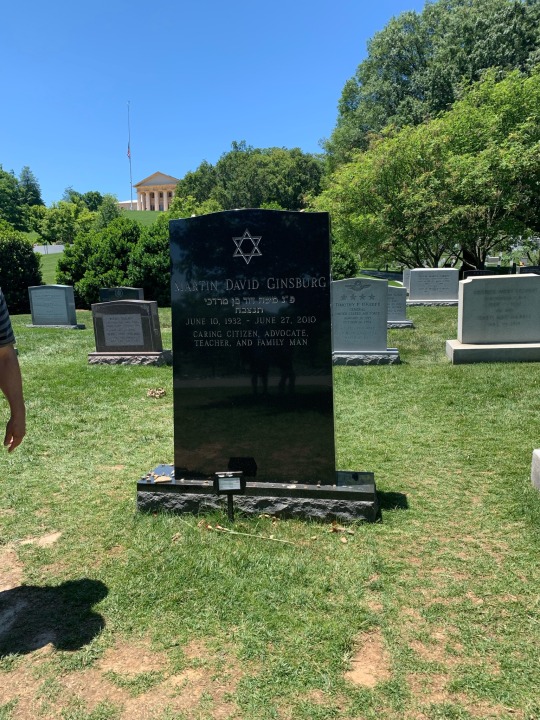
To conclude our long day, we returned to Lafayette Square to meet up with an alum from Randolph-Macon Woman’s College, Rebecca Grawl. We sought out her Lincoln assassination tour and were quickly impressed by her knowledge of the President and others involved in the night of April 15, 1865. Though most people know that John Wilkes Booth was the man who shot and killed the President, he was only one small component of a much larger plot which Lincoln’s assassin thought would allow the Confederacy to rise again after their defeat. We were first told about the night that President Lincoln and the First Lady were having at the White House before heading out to Ford’s Theater. Rebecca then shifted to the conspiracy to overthrow the American government. President Lincoln’s Secretary of State, William Seward, was also targeted by Lewis Powell that night. As Rebecca pointed out though, since Seward had been injured a few days before after falling off his horse, he was lying in the bed of his home with a cast protecting most of his body. Though he was stabbed in the neck and face dozens of times, Seward survived, and Powell was caught at the Mary Surratt Boarding House just a few days later. When Rebecca took our group a few blocks away to the spot where the Kirkwood House once stood, she talked about George Atzerodt, who was assigned to assassinate Vice President Andrew Johnson. However, before he could do so, he got drunk at the bar of the Kirkwood House and failed to go upstairs to kill Johnson. He was later found by the police at the home of his cousin in Maryland. Finally, we arrived at Ford’s Theater to listen to Rebecca describe the assassination of President Lincoln. Booth, a well-known actor at the time, told patrons in the bar next door that no one would ever forget his name. He infamously shot President Lincoln in the back of the head while he sat next to his wife, Mary Todd Lincoln, while they watched My American Cousin from a high private box. Major Henry Rathbone, who attended the play with the Lincoln’s and his fianceé Clara Harris, tried to stop Booth but was stabbed in the process. Booth jumped to the stage and shouted “Sic Semper Tyrannis,” a Latin phrase meaning "thus always to tyrants." Though Booth got away from the scene of his violent act, he was later found and killed by Union men. The other conspirators, Lewis Powell, Mary Surratt, George Atzerdot, and David Harold were executed by hanging just a few months later. Rebecca told an enthralling story about the deaths of one of the greatest and consequential presidents of our history. We cannot thank her enough for offering us this valuable experience in our busy Summer. One way our society memorializes and remembers Lincoln’s legacy is through tours like those offered by Rebecca’s company. We highly recommend searching for tours offered through DC by Foot.

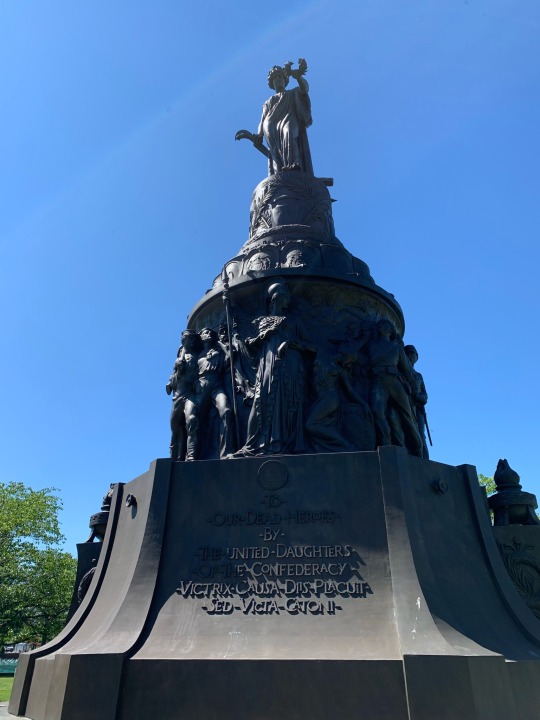
0 notes


